{"/api/v1/ncpl/currencies/getAll":{"body":[{"Name":"U.S. Dollar","Code":"USD","Symbol":"$","Separator":".","Culture":"en-US"},{"Name":"Euro","Code":"EUR","Symbol":"€","Separator":",","Culture":"en-US"},{"Name":"British Pound","Code":"GBP","Symbol":"£","Separator":".","Culture":"en-US"},{"Name":"Canadian Dollars","Code":"CAD","Symbol":"C$","Separator":".","Culture":"en-US"},{"Name":"Australian Dollars","Code":"AUD","Symbol":"A$","Separator":".","Culture":"en-US"},{"Name":"Indian Rupees","Code":"INR","Symbol":"Rs","Separator":".","Culture":"en-US"},{"Name":"China Yuan RMB","Code":"CNY","Symbol":"¥","Separator":".","Culture":"en-US"}],"status":200,"statusText":"OK"},"/api/v1/ncpl/cart/user/getShoppingCartSummary:\"{\\\"finalTotalOnly\\\":true}\"":{"body":null,"status":200,"statusText":"OK"},"/api/v1/ncpl/usermanagement/uiuser/getHeaderUserInfo:\"{\\\"hideSupportPin\\\":true}\"":{"body":{"__ctxId":"4FE1C37C4BB44C8797DED4FC33C8FD50","__isError":true,"__errorType":"Nc.Platform.Abstractions.UnauthorizedException","Http_WWW_Authenticate":"Bearer","StatusCode":"Unauthorized","LogLevel":3,"Message":"","InnerException":null,"HelpLink":null,"Source":"Nc.Security.Middleware"},"status":401,"statusText":"Unauthorized"}}{"/api/v1/ncpl/simplekb/getarticle:\"{\\\"articleId\\\":10188,\\\"categoryId\\\":2251}\"":{"body":{"Id":10188,"FriendlyId":"","ArticleTypeId":0,"Title":"Supersonic CDN overview","ArticleName":"Supersonic CDN overview","ArticleSummary":null,"PreponedSummary":false,"Approved":true,"Body":"DQoJCTxiPlN1cGVyc29uaWMgQ0ROPC9iPiB3aWxsIGhlbHAgYWNjZWxlcmF0ZSB5b3VyIHdlYnNpdGUgcGVyZm9ybWFuY2UgYW5kIGRlbGl2ZXIgY29udGVudCB0byB2aXNpdG9ycyBmYXN0LCBubyBtYXR0ZXIgd2hlcmUgdGhleeKAmXJlIGxvY2F0ZWQgaW4gdGhlIHdvcmxkLiBUaGlzIGd1aWRlIHdpbGwgaGVscCB5b3UgdW5kZXJzdGFuZCBob3cgQ0ROcyB3b3JrIGFuZCA8YSBocmVmPSJodHRwczovL3d3dy5uYW1lY2hlYXAuY29tL3N1cGVyc29uaWMtY2RuL2ZhcXMvIj5ob3cgU3VwZXJzb25pYyBDRE4gd29ya3M8L2E+LjxiciAvPjxiciAvPkEgPGI+Q0ROPC9iPiAoY29udGVudCBkZWxpdmVyeSBuZXR3b3JrKSBpcyBhIGdyb3VwIG9mIHNlcnZlcnMgdGhhdCBhcmUgZGlzdHJpYnV0ZWQgYWNyb3NzIHRoZSBnbG9iZSBmb3IgdGhlIHB1cnBvc2Ugb2YgY2FjaGluZyAoc3RvcmluZykgYW5kIGRlbGl2ZXJpbmcgYXNzZXRzIChjb250ZW50IHN1Y2ggYXMgaW1hZ2VzIGFuZCB2aWRlbywgZm9yIGV4YW1wbGUpIHRvIHdlYnNpdGUgdmlzaXRvcnMgZmFzdGVyLiA8YnIgLz48YnIgLz48ZGl2PjxhIGhyZWY9Imh0dHBzOi8vd3d3Lm5hbWVjaGVhcC5jb20vc3VwZXJzb25pYy1jZG4vIj5TdXBlcnNvbmljIENETjwvYT4gaGFzIGEgY29tcHJlaGVuc2l2ZSBpbnRlcmZhY2UgdGhhdCBnaXZlcyB5b3UgY29udHJvbCBvdmVyIGhvdyB5b3VyIGNvbnRlbnQgaXMgY2FjaGVkLiBOb3Qgb25seSB3aWxsIFN1cGVyc29uaWMgQ0ROIGluY3JlYXNlIHRoZSBwZXJmb3JtYW5jZSBvZiBhIHdlYnNpdGUsIGl0IGFsc28gY29tZXMgd2l0aCBhIHdob2xlIGhvc3Qgb2Ygb3RoZXIgZmVhdHVyZXMgdGhhdCB3aWxsIGltcHJvdmUgaXRzIHNlY3VyaXR5IGFuZCBzcGVlZC4gVGhlc2UgaW5jbHVkZSBERG9TIHByb3RlY3Rpb24sIFNTTCBoYW5kbGluZywgV2Vic2l0ZSBTZWN1cml0eSBhbmQgTW9uaXRvcmluZywgV2Vic2l0ZSBDb25maWd1cmF0aW9uLCBDYWNoZSBNYW5hZ2luZywgTG9hZCBCYWxhbmNpbmcsIGFuZCBtb3JlLjwvZGl2PjxkaXY+PGJyIC8+PC9kaXY+QmVmb3JlIHdlIGRpdmUgaW50byBhbGwgdGhhdCwgbGV04oCZcyBsZWFybiBtb3JlIGFib3V0IGhvdyBhIENETiB3b3Jrcy48YnIgLz48YnIgLz48YnIgLz48Yj5Ib3cgYSBDRE4gd29ya3M8L2I+PGJyIC8+PGJyIC8+PGJyIC8+RWFjaCByZXF1ZXN0IG1hZGUgdG8gYSB3ZWJzaXRlIChlLmcuIGEgdXNlciBsb2FkaW5nIGEgd2ViIHBhZ2UpIGhhcyB0byBnbyB0byB0aGUgb3JpZ2luIHNlcnZlciAoYmFzaWNhbGx5LCB0aGF0J3MgdGhlIHNlcnZlciB3aGVyZSB5b3VyIGNvbnRlbnQgaXMgaG9zdGVkIG9uKSwgZ2F0aGVyIHRoZSByZXF1ZXN0ZWQgYXNzZXRzIChjb250ZW50KSwgYW5kIHJldHVybiB0aGVtIHRvIHRoZSBjbGllbnQgKHlvdXIgdXNlcuKAmXMgY29tcHV0ZXIpLiBJZiB0aGUgZ2VvZ3JhcGhpY2FsIGxvY2F0aW9uIG9mwqAgYSBzZXJ2ZXIgYW5kIGEgY2xpZW50IGFyZSBmYXIgYXBhcnQg4oCUIGlmIHRoZXkgYXJlIGxvY2F0ZWQgb24gZGlmZmVyZW50IGNvbnRpbmVudHMsIGZvciBpbnN0YW5jZSDigJQgdGhpcyByZXF1ZXN0IGNhbiB0YWtlIGEgbG9uZyB0aW1lLCBtYWtpbmcgbG9hZCB0aW1lIHNsb3cuIFRoYXQncyB3aHkgaXQncyByZWNvbW1lbmRlZCB0byBjaG9vc2UgYSBkYXRhIGNlbnRlciB0aGF0IGlzIGxvY2F0ZWQgY2xvc2UgdG8geW91ciB0YXJnZXQgYXVkaWVuY2UuIDxiciAvPjxiciAvPjxkaXY+QSBDRE4gd29ya3MgdG8gbWluaW1pemUgdGhlIHZpcnR1YWwgZGlzdGFuY2UgYmV0d2VlbiB0aGUgd2Vic2l0ZeKAmXMgdmlzaXRvciBhbmQgdGhlIHdlYnNpdGXigJlzIHNlcnZlci4gSXQgZG9lcyB0aGlzIGJ5IHN0b3JpbmcgYSBjYWNoZWQgdmVyc2lvbiBvZiBpdHMgY29udGVudCBpbiBtdWx0aXBsZSBnZW9ncmFwaGljIGxvY2F0aW9ucyAoZWRnZSBzZXJ2ZXJzKS4gQnkgZG9pbmcgdGhpcywgY29udGVudCBjYW4gYmUgZGVsaXZlcmVkIHRvIGVuZC11c2VycyBtb3JlIHF1aWNrbHkgYW5kIHJlbGlhYmx5LiBXZSBoYXZlIG11bHRpcGxlIHBvaW50cyBvZiBwcmVzZW5jZSBhbGwgYXJvdW5kIHRoZSB3b3JsZCB3aGljaCBlbnN1cmVzIHlvdXIgd2Vic2l0ZSBpcyBxdWlja2x5IGxvYWRlZCBmb3IgYW55IHZpc2l0b3IgZnJvbSBhbnkgd29ybGQgbG9jYXRpb24uPC9kaXY+PGRpdj48YnIgLz48ZGl2PjwvZGl2PldpdGggYSBDRE4sIHlvdXIgY3VzdG9tZXJzIHNob3VsZCBiZSBhYmxlIHRvIGFjY2VzcyB5b3VyIHdlYnNpdGUgd2l0aGluIG1pbGxpc2Vjb25kcywgbm8gbWF0dGVyIHdoZXJlIHRoZXnigJlyZSBsb2NhdGVkLjxiciAvPjxiciAvPjxkaXY+QmVsb3cgeW91IGNhbiBmaW5kIGEgY29tcGFyaXNvbiBiZXR3ZWVuIG5vbi1DRE4gbmV0d29yayBhbmQgYSBDRE4gbmV0d29yazo8L2Rpdj48ZGl2PjxiciAvPjwvZGl2PjxkaXY+PGltZyBjbGFzcz0ia2ItaW1hZ2UiIHNyYz0iaHR0cHM6Ly9OYW1lY2hlYXAuc2ltcGxla2IuY29tL1NpdGVDb250ZW50cy8yLTdDMjJENTIzNkE0NTQzRUI4MjdGM0JEODkzNkUxNTNFL21lZGlhL0NETl9lZGdlLnBuZyIgYWx0PSJUd28gZ2xvYmFsIG1hcHMgc2hvdyB0aGUgZGlmZmVyZW5jZSBiZXR3ZWVuIG5vbiBDRE4gbmV0d29ya3MgYW5kIENETiBuZXR3b3JrcyIgLz48L2Rpdj48cD48L3A+PGJyIC8+PGRpdj48Yj5CZW5lZml0czwvYj46PC9kaXY+PGRpdj48YnIgLz48L2Rpdj48dWw+PGxpPjxiPlBhZ2UgbG9hZCBzcGVlZCBpbXByb3ZlbWVudDwvYj46IENETiBwcm92aWRlcyB0aGUgZmFzdCBkZWxpdmVyeSBvZiBJbnRlcm5ldCBjb250ZW50IGJ5IGNhY2hpbmcgaW5mb3JtYXRpb24gb24gbXVsdGlwbGUgc2VydmVycyBhcm91bmQgdGhlIGdsb2JlIHNvIHRoYXQgdXNlcnMgdGhhdCBwaWNrIHVwIGRhdGEgZnJvbSB0aGUgY2xvc2VzdCBzZXJ2ZXIgdG8gdGhlbS48L2xpPjxsaT48Yj5TaW1wbGUgc2V0dXA8L2I+OiBBIHdlbGwtZXN0YWJsaXNoZWQgd29ya2Zsb3cgYWxsb3dzIHlvdSB0byBzZXQgdXAgYW5kIG1hbmFnZSBDRE4gc2ltcGx5LiBTbyB5b3UgY2FuIGdldCB5b3VyIGNvbnRlbnQgZGVsaXZlcnkgdXAgYW5kIHJ1bm5pbmcgZmFzdCwgYW5kIGRvbuKAmXQgZ2V0IGxvc3QgaW4gc2NyZWVucyBvZiBzZXR0aW5ncyBhbmQgc3dpdGNoZXMuPC9saT48bGk+PGI+Q29udHJvbCBvZiBjYWNoaW5nPC9iPjogV2l0aCBoaWdoLWNhcGFjaXR5IFNTRHMgYW5kIGFkdmFuY2VkIGNhY2hpbmcgdGVjaG5pcXVlcywgd2UgcHJvdmlkZSBpbmR1c3RyeS1sZWFkaW5nIGNhY2hlIGRlcHRoIHRvIG1ha2UgbW9yZSBjb250ZW50IGF2YWlsYWJsZSBmb3IgbG9uZ2VyIGF0IHRoZSBlZGdlIHNlcnZlci48L2xpPjxsaT48Yj5GbGV4aWJsZSBDdXN0b21pemF0aW9uPC9iPjogWW91IGhhdmUgdGhlIGZyZWVkb20gdG8gY3VzdG9taXplIHlvdXIgYXNzZXQgZGVsaXZlcnksIHNlY3VyaXR5IG1lYXN1cmVzLCBTRU8sIGFuZCBtb2JpbGUgZXhwZXJpZW5jZSB0byB5b3VyIG5lZWRzLjwvbGk+PGxpPjxiPlJlYWwtdGltZSBhbmFseXRpY3M8L2I+OiBMZXZlcmFnZSBkZXRhaWxlZCBkYXRhIHBvaW50cyBhYm91dCBjb250ZW50IGRlbGl2ZXJ5IGFuZCB0cmFmZmljLCB3aXRoIGFkdmFuY2VkIHJlcG9ydGluZyBjYXBhYmlsaXRpZXMgYW5kIGFuYWx5dGljcy48L2xpPjwvdWw+PGJyIC8+PGRpdj48Yj5TdXBlcnNvbmljIENETiBEYXNoYm9hcmQ8L2I+PC9kaXY+PGRpdj48YnIgLz48L2Rpdj5Zb3UgY2FuIGFjY2VzcyB5b3VyIFN1cGVyc29uaWMgQ0ROIERhc2hib2FyZCBpbiB0aGUgZm9sbG93aW5nIHdheXM6PGJyIC8+PGJyIC8+MS4gVXNpbmcgdGhlIGRpcmVjdCBsaW5rOiA8YSBocmVmPSJodHRwczovL21hbmFnZS5zdXBlcnNvbmljLmFpL2xvZ2luIj5odHRwczovL21hbmFnZS5zdXBlcnNvbmljLmFpL2xvZ2luPC9hPjxiciAvPjxiciAvPjIuIEZyb20gd2l0aGluIHlvdXIgTmFtZWNoZWFwIGFjY291bnQsIGdvIHRvIHRoZSA8Yj5BcHBzPC9iPiBtZW51IGFuZCBjbGljayBvbiB0aGUgPGI+U3VwZXJzb25pYyBDRE4gbG9nbzwvYj46PGJyIC8+PGJyIC8+PGltZyBjbGFzcz0ia2ItaW1hZ2UiIHNyYz0iaHR0cHM6Ly9OYW1lY2hlYXAuc2ltcGxla2IuY29tL1NpdGVDb250ZW50cy8yLTdDMjJENTIzNkE0NTQzRUI4MjdGM0JEODkzNkUxNTNFL21lZGlhL2Nkbl9kYXNoYm9hcmRfMDEucG5nIiAvPjxiciAvPjxiciAvPjMuIEFsc28sIHlvdSBjYW4gYWNjZXNzIGl0IGZyb20geW91ciA8YSBocmVmPSJodHRwczovL2Rhc2hib2FyZC5lYXN5d3AuY29tIj5FYXN5V1AgRGFzaGJvYXJkPC9hPiAmZ3Q7Jmd0OyB0aGU8Yj4gQWRkLW9uczwvYj4gbWVudTo8YnIgLz48YnIgLz48aW1nIGNsYXNzPSJrYi1pbWFnZSIgc3JjPSJodHRwczovL05hbWVjaGVhcC5zaW1wbGVrYi5jb20vU2l0ZUNvbnRlbnRzLzItN0MyMkQ1MjM2QTQ1NDNFQjgyN0YzQkQ4OTM2RTE1M0UvbWVkaWEvY2RuX2FkZF9la2JfYmlnLnBuZyIgLz48YnIgLz48YnIgLz5Zb3Ugd2lsbCBiZSByZWRpcmVjdGVkIHRvIHRoZSBTdXBlcnNvbmljIENETiBsb2dpbiBwYWdlLiBDbGljayA8Yj5Mb2dpbiB3aXRoIE5hbWVjaGVhcDwvYj4gYW5kIHlvdSB3aWxsIGJlIGxvZ2dlZCBpbiB0byB0aGUgU3VwZXJzb25pYyBDRE4gRGFzaGJvYXJkIGF1dG9tYXRpY2FsbHk6PGJyIC8+PGJyIC8+PGltZyBjbGFzcz0ia2ItaW1hZ2UiIHNyYz0iaHR0cHM6Ly9OYW1lY2hlYXAuc2ltcGxla2IuY29tL1NpdGVDb250ZW50cy8yLTdDMjJENTIzNkE0NTQzRUI4MjdGM0JEODkzNkUxNTNFL21lZGlhL2Nkbl9kYXNoYm9hcmRfMDIucG5nIiAvPjxiciAvPjxiciAvPjxkaXY+PC9kaXY+PGRpdj5UaGUgU3VwZXJzb25pYyBDRE4gRGFzaGJvYXJkIGZlYXR1cmVzIHRoZSBmb2xsb3dpbmcgb3B0aW9uczo8YnIgLz48YnIgLz48dWw+PGxpPjxhIGhyZWY9IiNPdmVydmlldyI+T3ZlcnZpZXc8L2E+PC9saT48bGk+PGEgaHJlZj0iI0FuYWx5dGljcyI+QW5hbHl0aWNzPC9hPjwvbGk+PGxpPjxhIGhyZWY9IiNDRE4gU2V0dGluZ3MiPkNETiBTZXR0aW5nczwvYT48L2xpPjxsaT48YSBocmVmPSIjU1NMIj5TU0w8L2E+PC9saT48bGk+RmlyZXdhbGwgKHVwY29taW5nKTxiciAvPjwvbGk+PGxpPg0KTW9uaXRvciAodXBjb21pbmcpPC9saT48L3VsPjwvZGl2PjxkaXY+PGltZyBjbGFzcz0ia2ItaW1hZ2UiIHNyYz0iaHR0cHM6Ly9OYW1lY2hlYXAuc2ltcGxla2IuY29tL1NpdGVDb250ZW50cy8yLTdDMjJENTIzNkE0NTQzRUI4MjdGM0JEODkzNkUxNTNFL21lZGlhLzIwMjEtMDItMTFfMTQtMzkucG5nIiBhbHQ9IlRoZSBOYW1lY2hlYXAgQ0ROIGRhc2hib2FyZCIgLz48L2Rpdj48ZGl2PjxhIG5hbWU9Ik92ZXJ2aWV3Ij48Yj48YnIgLz48L2I+PC9hPjxwPjxhIG5hbWU9Ik92ZXJ2aWV3Ij48Yj5PdmVydmlldzwvYj48L2E+PC9wPjxiciAvPlRoZSBPdmVydmlldyB0YWIgY29udGFpbnMgcXVpY2stbGlua3MgZm9yIHNldHRpbmdzLCBhbmFseXRpY3MsIHBvcHVsYXIgZmVhdHVyZXMsIGFuZCBhY2Nlc3MgdG8gbWFuYWdlIHF1aWNrIGFjdGlvbnM6PC9kaXY+PGRpdj48YnIgLz48L2Rpdj48ZGl2PjxiPkNhY2hlPC9iPjogY2xlYXJzIGFsbCB0aGUgY2FjaGUgZnJvbSB0aGUgd2Vic2l0ZTwvZGl2PjxkaXY+PGI+RE5TIFJlY29yZHM8L2I+OiBhbGxvd3MgdG8gdG8gYXBwbHkgdGhlIGNvcnJlY3QgRE5TIHJlY29yZHMgZm9yIFN1cGVyc29uaWMgQ0ROPC9kaXY+PGRpdj48YnIgLz48L2Rpdj48cD48L3A+PGRpdj48aW1nIGNsYXNzPSJrYi1pbWFnZSIgc3JjPSJodHRwczovL05hbWVjaGVhcC5zaW1wbGVrYi5jb20vU2l0ZUNvbnRlbnRzLzItN0MyMkQ1MjM2QTQ1NDNFQjgyN0YzQkQ4OTM2RTE1M0UvbWVkaWEvMjAyMS0wMi0xMV8xNC00MC5wbmciIC8+PC9kaXY+PGRpdj48YnIgLz48L2Rpdj48cD48YSBuYW1lPSJBbmFseXRpY3MiPjxiPkFuYWx5dGljczwvYj48L2E+PC9wPjxkaXY+PC9kaXY+PGRpdj48YnIgLz48L2Rpdj48ZGl2PjxiPkNETjwvYj4gYW5hbHl0aWNzIGFsbG93cyB5b3UgdG8gY2hlY2sgdGhlIGJhbmR3aWR0aCBhbmQgdGhlIG51bWJlciBvZiByZXF1ZXN0cyB0byB5b3VyIHdlYnNpdGUuPGJyIC8+VGhlIGdyYXBoIGRpc3BsYXlzIGluZm9ybWF0aW9uIG9uIHRoZSBhbW91bnQgb2YgYmFuZHdpZHRoIHVzZWQgZnJvbSBkZWxpdmVyaW5nIENETiBhc3NldHMgYW5kIHRoZSBudW1iZXIgb2YgaW5kaXZpZHVhbCBIVFRQIHJlcXVlc3RzIGhhbmRsZWQgYnkgdGhlIENETi48YnIgLz48YnIgLz48L2Rpdj48ZGl2PjxiPlN0YXR1cyBDb2RlczwvYj48L2Rpdj48ZGl2PjxiPjwvYj48YnIgLz5EaWZmZXJlbnQgSFRUUCBzdGF0dXMgY29kZSBjYXJyaWVzIGRpZmZlcmVudCBtZWFuaW5ncyBvZiB0aGUgSFRUUCByZXF1ZXN0LiBTdGF0dXMgQ29kZXMgc2VjdGlvbiB3aWxsIHNob3cgeW91IHRoZSBvcmlnaW4gc2VydmVyIHRpbWVvdXRzLCBhbmQgdGhlIDR4eCBhbmQgNXh4IG9yaWdpbiBlcnJvcnMgaWYgdGhleSBhcHBlYXIuIEFsc28sIHRoZSBSZWRpcmVjdHMgc2VjdGlvbiBzaG93cyB5b3UgYWxsIDN4eCB3ZWJzaXRlIHJlZGlyZWN0cyAoMzAxIFBlcm1hbmVudCwgMzAyIFRlbXBvcmFyeSwgZXRjLikuPGJyIC8+PGJyIC8+PGI+Tk9URTwvYj46IFRoZSBTdGF0dXMgQ29kZXMgbWVudSBpcyBhdmFpbGFibGUgd2l0aCA8YSBocmVmPSJodHRwczovL3d3dy5uYW1lY2hlYXAuY29tL3N1cGVyc29uaWMtY2RuLyNhbGwtcGxhbnMiIGxpbmt0ZXh0PSJwYWlkIHBsYW5zIiBsaW5rdHlwZT0iQ3VzdG9tIiB0YXJnZXQ9Il9ibGFuayI+cGFpZCBwbGFuczwvYT4gb25seS4gPGJyIC8+PC9kaXY+PGRpdj48YnIgLz48L2Rpdj48ZGl2PjxpbWcgY2xhc3M9ImtiLWltYWdlIiBzcmM9Imh0dHBzOi8vTmFtZWNoZWFwLnNpbXBsZWtiLmNvbS9TaXRlQ29udGVudHMvMi03QzIyRDUyMzZBNDU0M0VCODI3RjNCRDg5MzZFMTUzRS9tZWRpYS9jZG5fYW5hbHl0aWNzLnBuZyIgLz48L2Rpdj48YnIgLz48ZGl2PjxiPkNhY2hlIEhpdCBSYXRpbzwvYj48L2Rpdj48ZGl2PjxiPjwvYj48YnIgLz5DYWNoZSBIaXQgUmF0aW8gc2hvd3MgaG93IG1hbnkgY29udGVudCByZXF1ZXN0cyBhIGNhY2hlIGNhbiBmaWxsIHN1Y2Nlc3NmdWxseSwgY29tcGFyZWQgdG8gdGhlIG51bWJlciBvZiByZXF1ZXN0cyBpdCByZWNlaXZlcy4gPGJyIC8+PC9kaXY+PGRpdj48YnIgLz48L2Rpdj48ZGl2Pjx1bD48bGk+PGI+VHJhbnNmZXIgSGl0IFJhdGlvPC9iPjogVGhlIGFtb3VudCBvZiBkYXRhIGRlbGl2ZXJlZCBmcm9tIHRoZSBDRE4gQ2FjaGUsIGRpdmlkZWQgYnkgdGhlIHRvdGFsIGFtb3VudCBvZiBkYXRhIGRlbGl2ZXJlZCBieSB0aGUgQ0ROIGZvciBhIGNlcnRhaW4gcGVyaW9kIG9mIHRpbWUuPC9saT48bGk+PGI+UmVxdWVzdCBIaXQgUmF0aW88L2I+OiBUaGUgbnVtYmVyIG9mIHJlcXVlc3RzIHRvIHRoZSBDRE4gQ2FjaGUsIGRpdmlkZWQgYnkgdGhlIHRvdGFsIG51bWJlciBvZiByZXF1ZXN0cyB0byB0aGUgQ0ROIChpbmNsdWRpbmcgY2FzZXMsIHdoZW4gQ0ROIGlzIHVuYWJsZSB0byBzZXJ2ZSBjb250ZW50IGZyb20gbmV0d29yayBjYWNoZSkgZm9yIGNvbnRlbnQgZGVsaXZlcnkgaW4gYSBjZXJ0YWluIHBlcmlvZCBvZiB0aW1lLjwvbGk+PC91bD48YnIgLz48L2Rpdj48ZGl2PjxpbWcgY2xhc3M9ImtiLWltYWdlIiBzcmM9Imh0dHBzOi8vTmFtZWNoZWFwLnNpbXBsZWtiLmNvbS9TaXRlQ29udGVudHMvMi03QzIyRDUyMzZBNDU0M0VCODI3RjNCRDg5MzZFMTUzRS9tZWRpYS9jZG5fY2FjaGVfcmF0aW8ucG5nIiAvPjwvZGl2PjxkaXY+PGRpdj48cD48YSBuYW1lPSJDRE4gU2V0dGluZ3MiPjxiPjxiciAvPjwvYj48L2E+PC9wPjxwPjxhIG5hbWU9IkNETiBTZXR0aW5ncyI+PGI+Q0ROIFNldHRpbmdzPGJyIC8+PC9iPjwvYT48L3A+PC9kaXY+PGRpdj48aW1nIGNsYXNzPSJrYi1pbWFnZSIgc3JjPSJodHRwczovL05hbWVjaGVhcC5zaW1wbGVrYi5jb20vU2l0ZUNvbnRlbnRzLzItN0MyMkQ1MjM2QTQ1NDNFQjgyN0YzQkQ4OTM2RTE1M0UvbWVkaWEvMjAyMS0wMi0xMV8xNC00MS5wbmciIC8+PC9kaXY+PGRpdj48YnIgLz48L2Rpdj5JbiB0aGUgQ0ROIFNldHRpbmdzIHRhYiwgeW91IGNhbiBzZWUgdGhlIDxiPk9yaWdpbiBBZGRyZXNzPC9iPiAoYWRkcmVzcyBvZiB5b3VyIHNlcnZlcikuIDxiciAvPlRoaXMgbGV0cyBTdXBlcnNvbmljIENETiBwdWxsIGRpcmVjdGx5IGZyb20geW91ciBzZXJ2ZXIuIFdlIHdpbGwgdXNlIGl0IHRvIHJldHJpZXZlIGNvbnRlbnQgZnJvbSB0aGUgb3JpZ2luIHNlcnZlci48YnIgLz48YnIgLz5UaGUgcmVjb3JkIHdpbGwgYmUgYWRkZWQgYXV0b21hdGljYWxseSB0byB0aGUgU3VwZXJzb25pYyBDRE4gc2V0dGluZ3MgZm9yIEVhc3lXUC1iYXNlZCB3ZWJzaXRlcy4gPGJyIC8+PGRpdj48YnIgLz48L2Rpdj48ZGl2PkZvciB0aGUgPGI+YXV0b21hdGljIGNvbmZpZ3VyYXRpb24gPC9iPmZvciBDRE4gd2l0aCBFYXN5V1Agc3Vic2NyaXB0aW9uLCB5b3Ugc2hvdWxkIHN0YXJ0IHRoZSBjb25maWd1cmF0aW9uIGZsb3cgZnJvbSB0aGUgRWFzeVdQIGFkbWluIGRhc2hib2FyZC48L2Rpdj48YnIgLz48ZGl2PjxiPk5PVEU8L2I+OiBDdXJyZW50bHksIFN1cGVyc29uaWMgQ0ROIGNhbiBiZSB1c2VkIG9ubHkgd2l0aCBkb21haW5zIChib3RoIE5hbWVjaGVhcC1yZWdpc3RlcmVkIGFuZCBleHRlcm5hbCkgcG9pbnRlZCB0byA8Yj5CYXNpYyBETlM8L2I+LCA8Yj5GcmVlIEROUzwvYj4sIDxiPlByZW1pdW0gRE5TPC9iPiwgb3IgPGI+V2ViLUhvc3RpbmcgRE5TPC9iPiBpZiB5b3UgYXJlIHVzaW5nIFNoYXJlZCBob3N0aW5nLjxiciAvPjwvZGl2PjxkaXY+PGJyIC8+PC9kaXY+PGRpdj5DaGVjayA8YSBocmVmPSJodHRwczovL3d3dy5uYW1lY2hlYXAuY29tL3N1cHBvcnQva25vd2xlZGdlYmFzZS9hcnRpY2xlLmFzcHgvMTAxOTEvMjI1MS9ob3ctdG8tc2V0dXAtc3VwZXJzb25pYy1jZG4td2l0aC1lYXN5d3AiIGxpbmt0ZXh0PSJ0aGlzIGd1aWRlIiBsaW5rdHlwZT0iQ3VzdG9tIiB0YXJnZXQ9Il9wYXJlbnQiPnRoaXMgZ3VpZGU8L2E+IGlmIHlvdSB3YW50IHRvIHNldCB1cCBhIFN1cGVyc29uaWMgQ0ROIHdpdGggRWFzeVdQLiBUbyBjb25maWd1cmUgU3VwZXJzb25pYyBDRE4gd2l0aCBTaGFyZWQgaG9zdGluZywgDQoNCg0KPGEgaHJlZj0iaHR0cHM6Ly93d3cubmFtZWNoZWFwLmNvbS9zdXBwb3J0L2tub3dsZWRnZWJhc2UvYXJ0aWNsZS5hc3B4LzEwMjI1LzIyNTEvaG93LXRvLXNldHVwLXN1cGVyc29uaWMtY2RuLXdpdGgtc2hhcmVkLWhvc3RpbmcvIj5mb2xsb3cgdGhlc2Ugc3RlcHM8L2E+Lg0KIDxiciAvPjwvZGl2PjxiciAvPjxkaXY+PGltZyBjbGFzcz0ia2ItaW1hZ2UiIHNyYz0iaHR0cHM6Ly9OYW1lY2hlYXAuc2ltcGxla2IuY29tL1NpdGVDb250ZW50cy8yLTdDMjJENTIzNkE0NTQzRUI4MjdGM0JEODkzNkUxNTNFL21lZGlhL2NkbmNhY2hlLnBuZyIgLz48L2Rpdj48ZGl2PjxiciAvPjwvZGl2PjxiPkNhY2hlIHB1cmdpbmc8L2I+IG1lYW5zIHJlbW92aW5nIGNhY2hlZCBjb250ZW50IGZyb20gQ0ROLiBXaGVuIHRoZSBjYWNoZSBpcyBwdXJnZWQsIGV2ZXJ5IG5ldyByZXF1ZXN0IHB1bGxzIHRoZSBsYXRlc3QgdmVyc2lvbiBvZiB0aGUgY29udGVudCBmcm9tIHlvdXIgPGEgaHJlZj0iaHR0cHM6Ly93d3cubmFtZWNoZWFwLmNvbS9zdXBlcnNvbmljLWNkbi9jZG5zLXZzLWhvc3RpbmcvIiBsaW5rdGV4dD0iaG9zdGluZyBzZXJ2ZXIiIGxpbmt0eXBlPSJDdXN0b20iIHRhcmdldD0iX3BhcmVudCI+aG9zdGluZyBzZXJ2ZXI8L2E+IGFuZCBhZGRzIHRoZSBsYXRlc3QgdmVyc2lvbiB0byBDRE4uPGJyIC8+PGJyIC8+SWYgeW91IHNlbGVjdCA8Yj5QdXJnZSBhbGw8L2I+IHRoZW4gYWxsIHRoZSBjYWNoZWQgY29udGVudCBvZiB5b3VyIHdlYnNpdGUgd2lsbCBiZSByZW1vdmVkIGZyb20gQ0ROLjxiciAvPjxiciAvPjxiPkN1c3RvbSBwdXJnZTwvYj4gYWxsb3dzIHlvdSB0byBjaG9vc2UgdGhlIGV4YWN0IGFzc2V0cyB0byBiZSBwdXJnZWQuPGJyIC8+PGJyIC8+PGRpdj48Yj5MaWZldGltZTwvYj4gc2V0cyB0aGUgbWF4aW11bSBsZW5ndGggb2YgdGltZSB0aGF0IHRoZSBDRE4gd2lsbCBjYWNoZSB5b3VyIGNvbnRlbnQgZm9yIGJlZm9yZSBnb2luZyBiYWNrIHRvIHRoZSBvcmlnaW4gc2VydmVyIHRvIGdldCBhIG5ldyBjb250ZW50LCBvciBkZWZlciB0byB0aGUgdmFsdWUgcGFzc2VkIGJ5IHlvdXIgb3JpZ2luIHNlcnZlci48Yj48YnIgLz48L2I+PC9kaXY+PGRpdj48Yj48YnIgLz48L2I+PC9kaXY+PHVsPjxsaT48Yj5PcmlnaW4gQ29udHJvbGxlZDwvYj46IFRoZSBDRE4gd2lsbCBob25vciB0aGUgY2FjaGUtY29udHJvbCBoZWFkZXJzLCBtZWFuaW5nIHRoYXQgaXQgd2lsbCBjYWNoZSBpbmZvcm1hdGlvbiBkdXJpbmcgdGhlIHRpbWUgc2V0IHVwIGJ5IHRoZSBvcmlnaW4gc2VydmVyLiBUaGUgY2FjaGUtY29udHJvbCBoZWFkZXIgaXMgdXNlZCB0byBzcGVjaWZ5IGRpcmVjdGl2ZXMgZm9yIGNhY2hpbmcgbWVjaGFuaXNtcyBpbiByZXF1ZXN0cyBhbmQgcmVzcG9uc2VzLiBJZiB5b3Ugc2VsZWN0IHRoZSBvcmlnaW4gY29udHJvbGxlZCBvcHRpb24gc2VsZWN0ZWQsIHlvdSBtYWtlIHRoZSBDRE4gY2FjaGUgdGhlIGluZm9ybWF0aW9uIGR1cmluZyB0aGUgdGltZSB0aGUgb3JpZ2luIHNlcnZlciBzZXQgdXAuIDwvbGk+PGxpPjxiPlNwZWNpZnkgQ0ROIFRUTDwvYj46IFlvdSB3aWxsIGNob29zZSB0aGUgbGVuZ3RoIG9mIHRpbWUgdGhlIENETiB3aWxsIGNhY2hlIHlvdXIgY29udGVudCBpZiB5b3Ugc2VsZWN0IHRoaXMgb3B0aW9uLiBUaGUgU3RhdGljIGNvbnRlbnQgKGFsbCBmaWxlcyBmb3IgYSB3ZWJzaXRlIHRoYXQgYXJlIHN0b3JlZCBvbiBhIHNlcnZlcikgd2lsbCBiZSBjYWNoZWQgKGFuZCB3aWxsIG5vdCBleHBpcmUpLiBEeW5hbWljIENvbnRlbnQgKGNoYW5nZWFibGUgY29udGVudCkgd2lsbCBiZSBjYWNoZWQgYmFzZWQgb24gdGhlIG9yaWdpbiBjYWNoZS1jb250cm9sIGhlYWRlcnMuPC9saT48bGk+PGI+TmV2ZXIgRXhwaXJlPC9iPjogU3RhdGljIENvbnRlbnQgd2lsbCBiZSBjYWNoZWQgYW5kIHdpbGwgbm90IGV4cGlyZSwgYW5kIENETiB3aWxsIHVzZSB0aGlzIHNhdmVkIGluZm9ybWF0aW9uIGVhY2ggdGltZSB3aGVuIGRlbGl2ZXJpbmcgY29udGVudC4gRm9yIGV4YW1wbGUsIHdoZW4geW91IGVuYWJsZSB0aGlzIG9wdGlvbiBhbmQgc3BlY2lmeSB0aGUgaGVhZGVyIG5hbWUgdGhlcmUsIHdlIHdpbGwgY2FjaGUgYWxsIHZlcnNpb25zIG9mIHRoYXQgZmlsZS48L2xpPjxsaT48Yj5EbyBOb3QgQ2FjaGU8L2I+OiBTdGF0aWMgYW5kIER5bmFtaWMgcmVzb3VyY2VzIHdpbGwgbm90IGJlIGNhY2hlZCwgYW5kIGEgcmVxdWVzdCB3aWxsIGJlIHNlbnQgdG8gdGhlIG9yaWdpbiBzZXJ2ZXIgZm9yIGVhY2ggcmVxdWVzdC4gVGhlcmUgYXJlIHNldmVyYWwgcmVhc29ucyB3aHkgeW91IG1pZ2h0IGRvIHRoaXMuIEZvciBleGFtcGxlLCBzb21lb25lIGNvdWxkIGJlIHVzaW5nIHR3byBzaXRlcyB3b3JraW5nIHRvZ2V0aGVyIGFuZCBvbmUgY291bGQgYmUgZHluYW1pYywgc28gb25lIGNhbiBkZWNpZGUgbm90IHRvIHVzZSBjYWNoZS4gU29tZW9uZSBtYXkgd2FudCB0byBoaWRlIHRoZSB3ZWJzaXRlIGJlaGluZCBDRE4gYW5kIHVzZSBpdCBhcyBhIHByb3h5LXBhc3MsIG9yIGNhY2hlIGp1c3Qgb25lIHR5cGUgb2YgZmlsZSBhbmQgZGVmaW5lIHRoaXMgYnkgZWRnZSBydWxlcywgZXRjLjwvbGk+PC91bD48Yj48YnIgLz5RdWVyeSBTdHJpbmcgQ29udHJvbDwvYj7CoGRldGVybWluZXMgaG93IHlvdSB3YW50IFN1cGVyc29uaWMgQ0ROIHRvIHRyZWF0IFVSTHMgdGhhdCBoYXZlIGEgcXVlcnkgc3RyaW5nLjxiciAvPsKgPGJyIC8+QSBxdWVyeSBzdHJpbmcgaXMgYSBwYXJ0IG9mIGEgVVJMIHRoYXQgY29udGFpbnMgc29tZSBwYXJhbWV0ZXJzLiBUaGV5IGFyZSBleHRlbnNpb25zIG9mIHRoZSBVUkwgdGhhdCBhcmUgdXNlZCB0byBoZWxwIGRlZmluZSBzcGVjaWZpYyBjb250ZW50IG9yIGFjdGlvbnMgYmFzZWQgb24gdGhlIGRhdGEgYmVpbmcgcGFzc2VkLjwvZGl2PjxkaXY+PGJyIC8+PC9kaXY+PGRpdj5IZXJlIGlzIGFuIGV4YW1wbGUgb2YgYSBxdWVyeSBzdHJpbmcgKGV2ZXJ5dGhpbmcgYWZ0ZXIgPGI+PzwvYj4gaXMgYSBxdWVyeSBzdHJpbmcpOjxiciAvPjxlbT48c3BhbiBjbGFzcz0ibm9saW5rIj5odHRwOi8vZXhhbXBsZS5jb20vb3Zlci90aGVyZT9fZ2E9Mi4zOTgwMDA5OS4xbmFtZT1mZXJzZmdoanN5PC9zcGFuPjwvZW0+PC9kaXY+PGRpdj48ZW0+PHNwYW4gY2xhc3M9Im5vbGluayI+PC9zcGFuPjwvZW0+PGJyIC8+PC9kaXY+PGRpdj5TZXR0aW5nIGEgcXVlcnkgc3RyaW5nIHdpbGwgYWxsb3cgeW91IHRvIGNhY2hlIHNlcGFyYXRlIHZlcnNpb25zIG9mIGFuIGFzc2V0IGJhc2VkIG9uIGEgdW5pcXVlIHN0cmluZy4gVGhlIHF1ZXJ5IHN0cmluZyBhbGxvd3MgeW91IHRvIGNvbnRyb2wgdGhlIGNhY2hpbmcgb2YgZGlmZmVyZW50IHZlcnNpb25zIG9mIHRoZSBzYW1lIGFzc2V0LCB0byBtYWtlIHN1cmUgcmVxdWVzdHMgZ2V0IHRoZSBjb3JyZWN0IHZlcnNpb24uPGJyIC8+PC9kaXY+PGRpdj48cD5UaGlzIGlzIHVzZWZ1bCBpZiB5b3UgaGF2ZSBVUkxzIGluIHlvdXIgc2l0ZSB3aXRoIHF1ZXJ5IHN0cmluZ3MgLSB0aGF0IGlzLCBpZiB5b3UgaGF2ZSBzZXZlcmFsIHZlcnNpb25zIG9mIHRoZSBzYW1lIGZpbGUuPC9wPjxwPlVSTHMgdGhhdCBjb250YWluIHN0cmluZyBwYXJhbWV0ZXJzIHdpbGwgYmUgY29udHJvbGxlZCBmcm9tIHlvdXIgb3JpZ2luIHNlcnZlci48YnIgLz48YnIgLz48L3A+PHVsPjxsaT48Yj5JZ25vcmUgcXVlcnkgc3RyaW5nczwvYj46IFdlIHdpbGwgbm90IGNhY2hlIGV2ZXJ5IHZlcnNpb24gb2YgcXVlcnkgc3RyaW5ncyBmb3IgdGhlIGVudGlyZSB3ZWJzaXRlLjwvbGk+PGxpPjxiPkNhY2hlIEFsbCBRdWVyeSBTdHJpbmdzPC9iPjogVGhpcyB3aWxsIGNhY2hlIGFsbCB2ZXJzaW9ucyBvZiBlYWNoIHF1ZXJ5IHN0cmluZyBmb3IgdGhlIGVudGlyZSB3ZWJzaXRlLjwvbGk+PGxpPjxiPkN1c3RvbTwvYj46IFlvdSBjYW4gc3BlY2lmeSBhIFVSTCBvciBjZXJ0YWluIFVSTHMgcGF0aHMgYnkgc2VwYXJhdGluZyB0aGVtIHdpdGggIiwiwqAgdG8gY2FjaGUgcXVlcnkgc3RyaW5ncyBmb3IuPGJyIC8+PGJyIC8+PC9saT48L3VsPjxwPldpdGggdGhlIGhlbHAgb2YgdGhlwqA8Yj5DYWNoZSBleGNlcHRpb248L2I+wqBvcHRpb24sIHlvdSBjYW4gY2hvb3NlIGEgVVJMIHRoYXQgd29u4oCZdCBiZSBjYWNoZWQg4oCUIGZvciBleGFtcGxlLCBpZiB5b3Ugd2FudCB0byBjYWNoZSBvbmx5IHN0YXRpYyBjb250ZW50LjwvcD48cD48L3A+PGJyIC8+PGI+R3ppcCBDb21wcmVzc2lvbjwvYj4gYWxsb3dzIHlvdSB0byByZWR1Y2UgdGhlIGZpbGUgc2l6ZSBvZiB5b3VyIGNvbnRlbnQsIHdoaWNoIHdpbGwgaW1wcm92ZSBkZWxpdmVyeSBzcGVlZC4gSXQgaXMgcG9zc2libGUgdG8gY2hvb3NlIGFtb25nIHRoZSA2IGxldmVscyBvZiBjb21wcmVzc2lvbi4gVGhlIGhpZ2hlciB0aGUgbGV2ZWwgLSB0aGUgaGlnaGVyIHRoZSBjb21wcmVzc2lvbi48YnIgLz48YnIgLz48cD48YSBuYW1lPSJTU0wiPjxiPlNTTDxiciAvPjwvYj48L2E+PC9wPjxkaXY+Q0ROIHNlcnZpY2UgZW5hYmxlZCBmb3IgdGhlIHdlYnNpdGUgcmVxdWlyZXMgYW4gU1NMIGNlcnRpZmljYXRlIGlzc3VlZCBmb3IgdGhlIHdlYnNpdGUgbmFtZSB0byBiZSBpbnN0YWxsZWQgZm9yIGJvdGggRWFzeVdQIGFuZCBDRE4uIFlvdSBjYW4gdXNlIHRoZSBzYW1lIGNlcnRpZmljYXRlIGZpbGVzLjwvZGl2PjxkaXY+PGJyIC8+PC9kaXY+PGRpdj5GZWVsIGZyZWUgdG8gY2hlY2sgPGEgaHJlZj0iaHR0cHM6Ly93d3cubmFtZWNoZWFwLmNvbS9zdXBwb3J0L2tub3dsZWRnZWJhc2UvYXJ0aWNsZS5hc3B4Lzk4NzQvMjIzOS9lYXN5d3AtaG93LXRvLWFkZC1zc2wtdG8teW91ci13b3JkcHJlc3Mtc2l0ZSIgbGlua3RleHQ9InRoaXMgZ3VpZGUiIGxpbmt0eXBlPSJDdXN0b20iIHRhcmdldD0iX3BhcmVudCI+dGhpcyBndWlkZTwvYT4gdG8gbGVhcm4gaG93IHRvIGFkZCBhbiBTU0wgY2VydGlmaWNhdGUgdG8geW91ciBFYXN5V1Agd2Vic2l0ZS48L2Rpdj48ZGl2PjxiciAvPjwvZGl2PjxkaXY+VGhlIHN0ZXBzIG9uIGhvdyB0byBpbnN0YWxsIHRoZSBTU0wgb24gQ0ROIGFyZSBkZXNjcmliZWQgaW4gPGEgaHJlZj0iaHR0cHM6Ly93d3cubmFtZWNoZWFwLmNvbS9zdXBwb3J0L2tub3dsZWRnZWJhc2UvYXJ0aWNsZS5hc3B4LzEwMTkyLzIyMzkvaW5zdGFsbGluZy1hbi1zc2wtY2VydGlmaWNhdGUtb24tc3VwZXJzb25pYy1jZG4iIGxpbmt0ZXh0PSJ0aGlzIGFydGljbGUiIGxpbmt0eXBlPSJDdXN0b20iIHRhcmdldD0iX3BhcmVudCI+dGhpcyBhcnRpY2xlPC9hPi48YnIgLz48L2Rpdj48cD48L3A+PGRpdj48aW1nIGNsYXNzPSJrYi1pbWFnZSIgc3JjPSJodHRwczovL05hbWVjaGVhcC5zaW1wbGVrYi5jb20vU2l0ZUNvbnRlbnRzLzItN0MyMkQ1MjM2QTQ1NDNFQjgyN0YzQkQ4OTM2RTE1M0UvbWVkaWEvMjAyMS0wMi0xMV8xNC00Ml8xLnBuZyIgLz48L2Rpdj48ZGl2PjxiciAvPjwvZGl2PjxwPjwvcD48ZGl2PlRoYXQncyBpdCE8L2Rpdj48ZGl2PjxiciAvPjwvZGl2PjxkaXY+PGJyIC8+PC9kaXY+PGRpdiBhbGlnbj0iY2VudGVyIj5OZWVkIGFueSBoZWxwPyBDb250YWN0IG91ciA8YSBocmVmPSJodHRwczovL3d3dy5uYW1lY2hlYXAuY29tL2hlbHAtY2VudGVyL2xpdmUtY2hhdCIgbGlua3RleHQ9IkhlbHBEZXNrIiBsaW5rdHlwZT0iQ3VzdG9tIiB0YXJnZXQ9Il9wYXJlbnQiPkhlbHBEZXNrPC9hPjxiciAvPjwvZGl2PjxkaXY+PHNwYW4gaWQ9ImN0bDAwX2N0bDAwX2N0bDAwX2N0bDAwX2Jhc2VfY29udGVudF93ZWJfYmFzZV9jb250ZW50X2hvbWVfY29udGVudF9wYWdlX2NvbnRlbnRfbGVmdF9BcnRpY2xlSW5mb0Rpc3BsYXlDb250cm9sMSI+PHNwYW4+PGJyIC8+PC9zcGFuPjwvc3Bhbj48L2Rpdj48L2Rpdj48L2Rpdj4=","NewTillDate":null,"FeaturedTillDate":null,"ModifiedDateTime":"2025-07-09T12:24:27.0000000","LiveDateTime":"1754-02-02T00:00:00.0000000","CreatedDateTime":"2019-12-03T10:00:14.0000000","ApprovalDatetime":"2019-12-03T12:50:13.0000000","RequestCount":38790,"MarkedAsNew":false,"MarkedAsFeatured":false,"RatingValue":0,"CategoryPaths":[{"__type":"Nc:SimpleKB:Abstractions:Dtos:CategoryPathDto","Level":1,"CategoryId":2228,"CategoryName":"Apps"},{"__type":"Nc:SimpleKB:Abstractions:Dtos:CategoryPathDto","Level":2,"CategoryId":2251,"CategoryName":"Supersonic CDN"}],"AssociatedCategories":[{"CategoryId":2251,"CategoryName":"Supersonic CDN","CategoryDisplayName":"AppsSupersonic CDN"}],"AssociatedTags":[{"TagId":66473,"Tag":"CDN"},{"TagId":66474,"Tag":" Supersonic CDN"},{"TagId":83133,"Tag":" overview"}],"RelatedArticles":[{"ArticleId":10190,"PreferedCategoryId":2251,"ArticleTypeId":0,"ArticleName":"How to upgrade/downgrade Supersonic CDN","ArticleTypeName":null,"Title":"How to upgrade/downgrade Supersonic CDN","LiveDateTime":null,"ModifiedDateTime":"02/18/2021","MarkedAsNew":false,"MarkedAsFeatured":false},{"ArticleId":10192,"PreferedCategoryId":2251,"ArticleTypeId":0,"ArticleName":"Installing an SSL certificate on Supersonic CDN","ArticleTypeName":null,"Title":"Installing an SSL certificate on Supersonic CDN","LiveDateTime":null,"ModifiedDateTime":"02/09/2023","MarkedAsNew":false,"MarkedAsFeatured":false},{"ArticleId":10191,"PreferedCategoryId":2251,"ArticleTypeId":0,"ArticleName":"How to setup Supersonic CDN with EasyWP","ArticleTypeName":null,"Title":"How to setup Supersonic CDN with EasyWP","LiveDateTime":null,"ModifiedDateTime":"07/09/2025","MarkedAsNew":false,"MarkedAsFeatured":false}],"AssociatedMedias":[],"PreferredCategoryId":0,"RootParentCategoryName":"","RootParentCategoryId":0},"status":200,"statusText":"OK"},"/api/v1/ncpl/simplekb/getcategorybycategoryid:\"{\\\"categoryId\\\":2251}\"":{"body":{"__type":"Nc:SimpleKB:Abstractions:Dtos:CategoryDto","ParentCategoryId":2228,"Parent_Category_Name":"Apps","FriendlyId":null,"ApprovedYN":true,"TreatAsTopicYN":false,"CreatedDateTime":"12/03/2019 12:16:02","CurrentCategoryPaths":[{"__type":"Nc:SimpleKB:Abstractions:Dtos:CategoryPathDto","Level":1,"CategoryId":2228,"CategoryName":"Apps"},{"__type":"Nc:SimpleKB:Abstractions:Dtos:CategoryPathDto","Level":2,"CategoryId":2251,"CategoryName":"Supersonic CDN"}],"RelatedCategories":[],"AssociatedArticles":[{"ArticleId":10188,"Title":"Supersonic CDN overview","ArticleName":"Supersonic CDN overview","LiveDateTime":"02/02/1754 00:00:00","NewTillDate":null,"FeaturedTillDate":null,"ModifiedDateTime":"07/09/2025"},{"ArticleId":10190,"Title":"How to upgrade/downgrade Supersonic CDN","ArticleName":"How to upgrade/downgrade Supersonic CDN","LiveDateTime":"02/02/1754 00:00:00","NewTillDate":null,"FeaturedTillDate":null,"ModifiedDateTime":"02/18/2021"},{"ArticleId":10191,"Title":"How to setup Supersonic CDN with EasyWP","ArticleName":"How to setup Supersonic CDN with EasyWP","LiveDateTime":"02/02/1754 00:00:00","NewTillDate":null,"FeaturedTillDate":null,"ModifiedDateTime":"07/09/2025"},{"ArticleId":10192,"Title":"Installing an SSL certificate on Supersonic CDN","ArticleName":"Installing an SSL certificate on Supersonic CDN","LiveDateTime":"02/02/1754 00:00:00","NewTillDate":null,"FeaturedTillDate":null,"ModifiedDateTime":"02/09/2023"},{"ArticleId":10225,"Title":"How to setup Supersonic CDN with Shared hosting","ArticleName":"How to setup Supersonic CDN with Shared hosting","LiveDateTime":"02/02/1754 00:00:00","NewTillDate":null,"FeaturedTillDate":null,"ModifiedDateTime":"06/10/2025"},{"ArticleId":10452,"Title":"How to change domain for a Supersonic CDN subscription","ArticleName":"How to change domain for a Supersonic CDN subscription","LiveDateTime":"02/02/1754 00:00:00","NewTillDate":null,"FeaturedTillDate":null,"ModifiedDateTime":"05/20/2021"},{"ArticleId":10469,"Title":"How to purchase a Supersonic CDN subscription","ArticleName":"How to purchase a Supersonic CDN subscription","LiveDateTime":"02/02/1754 00:00:00","NewTillDate":null,"FeaturedTillDate":null,"ModifiedDateTime":"02/17/2023"},{"ArticleId":10470,"Title":"How to set up Supersonic CDN","ArticleName":"How to set up Supersonic CDN","LiveDateTime":"02/02/1754 00:00:00","NewTillDate":null,"FeaturedTillDate":null,"ModifiedDateTime":"06/24/2021"},{"ArticleId":10559,"Title":"How to fix a corrupted wp-admin page","ArticleName":"How to fix a corrupted wp-admin page","LiveDateTime":"02/02/1754 00:00:00","NewTillDate":null,"FeaturedTillDate":null,"ModifiedDateTime":"10/07/2022"},{"ArticleId":10672,"Title":"How to remove the CDN service for a domain","ArticleName":"How to remove the CDN service for a domain","LiveDateTime":"02/02/1754 00:00:00","NewTillDate":null,"FeaturedTillDate":null,"ModifiedDateTime":"02/05/2025"}],"AssociatedTags":[],"CategoryId":2251,"CategoryName":"Supersonic CDN"},"status":200,"statusText":"OK"},"/api/v1/ncpl/simplekb/getcategories:\"{\\\"parentCategoryId\\\":0,\\\"getTree\\\":true}\"":{"body":[{"__type":"Nc:SimpleKB:Abstractions:Dtos:CategoryItemDto","ParentCategoryId":93,"TreatAsTopicYN":false,"Description":"","ImageUrl":"","ShortDesc":"","CategoryId":2216,"CategoryName":"Spam Protection"},{"__type":"Nc:SimpleKB:Abstractions:Dtos:CategoryItemDto","ParentCategoryId":14,"TreatAsTopicYN":false,"Description":"","ImageUrl":"","ShortDesc":"","CategoryId":2217,"CategoryName":"Renewal"},{"__type":"Nc:SimpleKB:Abstractions:Dtos:CategoryItemDto","ParentCategoryId":14,"TreatAsTopicYN":false,"Description":"","ImageUrl":"","ShortDesc":"","CategoryId":2218,"CategoryName":"cPanel SSL Plugin"},{"__type":"Nc:SimpleKB:Abstractions:Dtos:CategoryItemDto","ParentCategoryId":12,"TreatAsTopicYN":false,"Description":"","ImageUrl":"","ShortDesc":"","CategoryId":2219,"CategoryName":"PHP Configuration"},{"__type":"Nc:SimpleKB:Abstractions:Dtos:CategoryItemDto","ParentCategoryId":14,"TreatAsTopicYN":false,"Description":"","ImageUrl":"","ShortDesc":"","CategoryId":2221,"CategoryName":"Multi-Domain SSL Certificates"},{"__type":"Nc:SimpleKB:Abstractions:Dtos:CategoryItemDto","ParentCategoryId":14,"TreatAsTopicYN":false,"Description":"","ImageUrl":"","ShortDesc":"","CategoryId":2222,"CategoryName":"Cancellation"},{"__type":"Nc:SimpleKB:Abstractions:Dtos:CategoryItemDto","ParentCategoryId":14,"TreatAsTopicYN":false,"Description":"","ImageUrl":"","ShortDesc":"","CategoryId":2223,"CategoryName":"Browser errors"},{"__type":"Nc:SimpleKB:Abstractions:Dtos:CategoryItemDto","ParentCategoryId":14,"TreatAsTopicYN":false,"Description":"","ImageUrl":"","ShortDesc":"","CategoryId":2224,"CategoryName":"Site Seal, Logo"},{"__type":"Nc:SimpleKB:Abstractions:Dtos:CategoryItemDto","ParentCategoryId":12,"TreatAsTopicYN":false,"Description":"","ImageUrl":"","ShortDesc":"","CategoryId":2225,"CategoryName":"SEO"},{"__type":"Nc:SimpleKB:Abstractions:Dtos:CategoryItemDto","ParentCategoryId":93,"TreatAsTopicYN":false,"Description":"","ImageUrl":"","ShortDesc":"","CategoryId":2226,"CategoryName":"Email Migration"},{"__type":"Nc:SimpleKB:Abstractions:Dtos:CategoryItemDto","ParentCategoryId":2211,"TreatAsTopicYN":false,"Description":"","ImageUrl":"","ShortDesc":"","CategoryId":2227,"CategoryName":"SSL Resellers"},{"__type":"Nc:SimpleKB:Abstractions:Dtos:CategoryItemDto","ParentCategoryId":0,"TreatAsTopicYN":true,"Description":"","ImageUrl":"/assets/img/pictograms/150/cloud-red.png","ShortDesc":"","CategoryId":2228,"CategoryName":"Apps","SubCategories":[{"__type":"Nc:SimpleKB:Abstractions:Dtos:CategoryItemDto","ParentCategoryId":2228,"TreatAsTopicYN":false,"Description":"","ImageUrl":"","ShortDesc":"","CategoryId":2251,"CategoryName":"Supersonic CDN"},{"__type":"Nc:SimpleKB:Abstractions:Dtos:CategoryItemDto","ParentCategoryId":2228,"TreatAsTopicYN":false,"Description":"","ImageUrl":"","ShortDesc":"","CategoryId":2298,"CategoryName":"Site Maker"},{"__type":"Nc:SimpleKB:Abstractions:Dtos:CategoryItemDto","ParentCategoryId":2228,"TreatAsTopicYN":false,"Description":"","ImageUrl":"","ShortDesc":"","CategoryId":177,"CategoryName":"Google Workspace (formerly G Suite)"}]},{"__type":"Nc:SimpleKB:Abstractions:Dtos:CategoryItemDto","ParentCategoryId":2211,"TreatAsTopicYN":false,"Description":"","ImageUrl":"","ShortDesc":"","CategoryId":2229,"CategoryName":"Hosting Resellers"},{"__type":"Nc:SimpleKB:Abstractions:Dtos:CategoryItemDto","ParentCategoryId":34,"TreatAsTopicYN":false,"Description":"","ImageUrl":"","ShortDesc":"","CategoryId":2232,"CategoryName":"DNSSEC"},{"__type":"Nc:SimpleKB:Abstractions:Dtos:CategoryItemDto","ParentCategoryId":34,"TreatAsTopicYN":false,"Description":"","ImageUrl":"","ShortDesc":"","CategoryId":2234,"CategoryName":"Google Workspace (formerly G Suite)"},{"__type":"Nc:SimpleKB:Abstractions:Dtos:CategoryItemDto","ParentCategoryId":34,"TreatAsTopicYN":false,"Description":"","ImageUrl":"","ShortDesc":"","CategoryId":2237,"CategoryName":"Host records setup"},{"__type":"Nc:SimpleKB:Abstractions:Dtos:CategoryItemDto","ParentCategoryId":14,"TreatAsTopicYN":false,"Description":"","ImageUrl":"","ShortDesc":"","CategoryId":2238,"CategoryName":"SSL installation errors"},{"__type":"Nc:SimpleKB:Abstractions:Dtos:CategoryItemDto","ParentCategoryId":0,"TreatAsTopicYN":false,"Description":"","ImageUrl":"/assets/img/pictograms/150/easywp-red.png","ShortDesc":"","CategoryId":2239,"CategoryName":"EasyWP","SubCategories":[{"__type":"Nc:SimpleKB:Abstractions:Dtos:CategoryItemDto","ParentCategoryId":2239,"TreatAsTopicYN":false,"Description":"","ImageUrl":"","ShortDesc":"","CategoryId":2280,"CategoryName":"Getting Started"},{"__type":"Nc:SimpleKB:Abstractions:Dtos:CategoryItemDto","ParentCategoryId":2239,"TreatAsTopicYN":false,"Description":"","ImageUrl":"","ShortDesc":"","CategoryId":2279,"CategoryName":"General Information"},{"__type":"Nc:SimpleKB:Abstractions:Dtos:CategoryItemDto","ParentCategoryId":2239,"TreatAsTopicYN":false,"Description":"","ImageUrl":"","ShortDesc":"","CategoryId":2281,"CategoryName":"WordPress Migration"},{"__type":"Nc:SimpleKB:Abstractions:Dtos:CategoryItemDto","ParentCategoryId":2239,"TreatAsTopicYN":false,"Description":"","ImageUrl":"","ShortDesc":"","CategoryId":2282,"CategoryName":"Plugins and Themes"},{"__type":"Nc:SimpleKB:Abstractions:Dtos:CategoryItemDto","ParentCategoryId":2239,"TreatAsTopicYN":false,"Description":"","ImageUrl":"","ShortDesc":"","CategoryId":2284,"CategoryName":"WordPress Management"},{"__type":"Nc:SimpleKB:Abstractions:Dtos:CategoryItemDto","ParentCategoryId":2239,"TreatAsTopicYN":false,"Description":"","ImageUrl":"","ShortDesc":"","CategoryId":2285,"CategoryName":"SFTP and Database access"},{"__type":"Nc:SimpleKB:Abstractions:Dtos:CategoryItemDto","ParentCategoryId":2239,"TreatAsTopicYN":false,"Description":"","ImageUrl":"","ShortDesc":"","CategoryId":2286,"CategoryName":"Domains questions"},{"__type":"Nc:SimpleKB:Abstractions:Dtos:CategoryItemDto","ParentCategoryId":2239,"TreatAsTopicYN":false,"Description":"","ImageUrl":"","ShortDesc":"","CategoryId":2288,"CategoryName":"Billing questions"},{"__type":"Nc:SimpleKB:Abstractions:Dtos:CategoryItemDto","ParentCategoryId":2239,"TreatAsTopicYN":false,"Description":"","ImageUrl":"","ShortDesc":"","CategoryId":2287,"CategoryName":"SSL questions"}]},{"__type":"Nc:SimpleKB:Abstractions:Dtos:CategoryItemDto","ParentCategoryId":2228,"TreatAsTopicYN":false,"Description":"","ImageUrl":"","ShortDesc":"","CategoryId":2251,"CategoryName":"Supersonic CDN"},{"__type":"Nc:SimpleKB:Abstractions:Dtos:CategoryItemDto","ParentCategoryId":12,"TreatAsTopicYN":false,"Description":"","ImageUrl":"","ShortDesc":"","CategoryId":2252,"CategoryName":"InterWorx questions"},{"__type":"Nc:SimpleKB:Abstractions:Dtos:CategoryItemDto","ParentCategoryId":2253,"TreatAsTopicYN":false,"Description":"","ImageUrl":"","ShortDesc":"","CategoryId":2254,"CategoryName":"Domains How-To"},{"__type":"Nc:SimpleKB:Abstractions:Dtos:CategoryItemDto","ParentCategoryId":2253,"TreatAsTopicYN":false,"Description":"","ImageUrl":"","ShortDesc":"","CategoryId":2255,"CategoryName":"Hosting How-To"},{"__type":"Nc:SimpleKB:Abstractions:Dtos:CategoryItemDto","ParentCategoryId":2253,"TreatAsTopicYN":false,"Description":"","ImageUrl":"","ShortDesc":"","CategoryId":2257,"CategoryName":"Sales & Payments How-To"},{"__type":"Nc:SimpleKB:Abstractions:Dtos:CategoryItemDto","ParentCategoryId":2253,"TreatAsTopicYN":false,"Description":"","ImageUrl":"","ShortDesc":"","CategoryId":2258,"CategoryName":"cPanel Email How-To"},{"__type":"Nc:SimpleKB:Abstractions:Dtos:CategoryItemDto","ParentCategoryId":93,"TreatAsTopicYN":false,"Description":"","ImageUrl":"","ShortDesc":"","CategoryId":2260,"CategoryName":"Private Email Contacts and Calendars Setup"},{"__type":"Nc:SimpleKB:Abstractions:Dtos:CategoryItemDto","ParentCategoryId":2253,"TreatAsTopicYN":false,"Description":"","ImageUrl":"","ShortDesc":"","CategoryId":2262,"CategoryName":"EasyWP How-To"},{"__type":"Nc:SimpleKB:Abstractions:Dtos:CategoryItemDto","ParentCategoryId":0,"TreatAsTopicYN":false,"Description":"","ImageUrl":"https://download.namecheap.com/assets/img/domainvault-red@2x.png","ShortDesc":"","CategoryId":2289,"CategoryName":"Domain Vault","SubCategories":[]},{"__type":"Nc:SimpleKB:Abstractions:Dtos:CategoryItemDto","ParentCategoryId":14,"TreatAsTopicYN":false,"Description":"","ImageUrl":"","ShortDesc":"","CategoryId":2290,"CategoryName":"CSR code"},{"__type":"Nc:SimpleKB:Abstractions:Dtos:CategoryItemDto","ParentCategoryId":12,"TreatAsTopicYN":false,"Description":"","ImageUrl":"","ShortDesc":"","CategoryId":2291,"CategoryName":"Webuzo questions"},{"__type":"Nc:SimpleKB:Abstractions:Dtos:CategoryItemDto","ParentCategoryId":2265,"TreatAsTopicYN":false,"Description":"","ImageUrl":"","ShortDesc":"","CategoryId":2292,"CategoryName":"Browser Extensions"},{"__type":"Nc:SimpleKB:Abstractions:Dtos:CategoryItemDto","ParentCategoryId":14,"TreatAsTopicYN":false,"Description":"","ImageUrl":"","ShortDesc":"","CategoryId":2293,"CategoryName":"Automated SSL management"},{"__type":"Nc:SimpleKB:Abstractions:Dtos:CategoryItemDto","ParentCategoryId":2228,"TreatAsTopicYN":false,"Description":"","ImageUrl":"","ShortDesc":"","CategoryId":2298,"CategoryName":"Site Maker"},{"__type":"Nc:SimpleKB:Abstractions:Dtos:CategoryItemDto","ParentCategoryId":12,"TreatAsTopicYN":false,"Description":"","ImageUrl":"","ShortDesc":"","CategoryId":27,"CategoryName":"Getting Started"},{"__type":"Nc:SimpleKB:Abstractions:Dtos:CategoryItemDto","ParentCategoryId":0,"TreatAsTopicYN":false,"Description":"","ImageUrl":"/assets/img/pictograms/150/support-red.png","ShortDesc":"","CategoryId":5,"CategoryName":"General & Support","SubCategories":[]},{"__type":"Nc:SimpleKB:Abstractions:Dtos:CategoryItemDto","ParentCategoryId":2200,"TreatAsTopicYN":false,"Description":"","ImageUrl":"","ShortDesc":"","CategoryId":7,"CategoryName":"Billing FAQ"},{"__type":"Nc:SimpleKB:Abstractions:Dtos:CategoryItemDto","ParentCategoryId":2209,"TreatAsTopicYN":false,"Description":"","ImageUrl":"","ShortDesc":"","CategoryId":8,"CategoryName":"Transfer Information"},{"__type":"Nc:SimpleKB:Abstractions:Dtos:CategoryItemDto","ParentCategoryId":12,"TreatAsTopicYN":false,"Description":"","ImageUrl":"","ShortDesc":"","CategoryId":22,"CategoryName":"Hosting Information"},{"__type":"Nc:SimpleKB:Abstractions:Dtos:CategoryItemDto","ParentCategoryId":14,"TreatAsTopicYN":false,"Description":"","ImageUrl":"","ShortDesc":"","CategoryId":38,"CategoryName":"SSL General"},{"__type":"Nc:SimpleKB:Abstractions:Dtos:CategoryItemDto","ParentCategoryId":9,"TreatAsTopicYN":false,"Description":"","ImageUrl":"","ShortDesc":"","CategoryId":45,"CategoryName":"Account Security"},{"__type":"Nc:SimpleKB:Abstractions:Dtos:CategoryItemDto","ParentCategoryId":34,"TreatAsTopicYN":false,"Description":"","ImageUrl":"","ShortDesc":"","CategoryId":46,"CategoryName":"Domain Management"},{"__type":"Nc:SimpleKB:Abstractions:Dtos:CategoryItemDto","ParentCategoryId":2211,"TreatAsTopicYN":false,"Description":"","ImageUrl":"","ShortDesc":"","CategoryId":63,"CategoryName":"Namecheap API"},{"__type":"Nc:SimpleKB:Abstractions:Dtos:CategoryItemDto","ParentCategoryId":2228,"TreatAsTopicYN":false,"Description":"","ImageUrl":"","ShortDesc":"","CategoryId":177,"CategoryName":"Google Workspace (formerly G Suite)"},{"__type":"Nc:SimpleKB:Abstractions:Dtos:CategoryItemDto","ParentCategoryId":93,"TreatAsTopicYN":false,"Description":"","ImageUrl":"","ShortDesc":"","CategoryId":2179,"CategoryName":"Private Email: General Information"},{"__type":"Nc:SimpleKB:Abstractions:Dtos:CategoryItemDto","ParentCategoryId":2265,"TreatAsTopicYN":false,"Description":"","ImageUrl":"","ShortDesc":"","CategoryId":2274,"CategoryName":"General"},{"__type":"Nc:SimpleKB:Abstractions:Dtos:CategoryItemDto","ParentCategoryId":2239,"TreatAsTopicYN":false,"Description":"","ImageUrl":"","ShortDesc":"","CategoryId":2280,"CategoryName":"Getting Started"},{"__type":"Nc:SimpleKB:Abstractions:Dtos:CategoryItemDto","ParentCategoryId":2239,"TreatAsTopicYN":false,"Description":"","ImageUrl":"","ShortDesc":"","CategoryId":2279,"CategoryName":"General Information"},{"__type":"Nc:SimpleKB:Abstractions:Dtos:CategoryItemDto","ParentCategoryId":93,"TreatAsTopicYN":false,"Description":"","ImageUrl":"","ShortDesc":"","CategoryId":2215,"CategoryName":"Private Email: Mailbox Management"},{"__type":"Nc:SimpleKB:Abstractions:Dtos:CategoryItemDto","ParentCategoryId":2211,"TreatAsTopicYN":false,"Description":"","ImageUrl":"","ShortDesc":"","CategoryId":2196,"CategoryName":"WHMCS module for SSL"},{"__type":"Nc:SimpleKB:Abstractions:Dtos:CategoryItemDto","ParentCategoryId":0,"TreatAsTopicYN":false,"Description":"","ImageUrl":"/assets/img/pictograms/150/savings-red.png","ShortDesc":"","CategoryId":2200,"CategoryName":"Checkout & Billing","SubCategories":[{"__type":"Nc:SimpleKB:Abstractions:Dtos:CategoryItemDto","ParentCategoryId":2200,"TreatAsTopicYN":false,"Description":"","ImageUrl":"","ShortDesc":"","CategoryId":7,"CategoryName":"Billing FAQ"},{"__type":"Nc:SimpleKB:Abstractions:Dtos:CategoryItemDto","ParentCategoryId":2200,"TreatAsTopicYN":false,"Description":"","ImageUrl":"","ShortDesc":"","CategoryId":2201,"CategoryName":"Domains Billing"},{"__type":"Nc:SimpleKB:Abstractions:Dtos:CategoryItemDto","ParentCategoryId":2200,"TreatAsTopicYN":false,"Description":"","ImageUrl":"","ShortDesc":"","CategoryId":21,"CategoryName":"Hosting Billing"},{"__type":"Nc:SimpleKB:Abstractions:Dtos:CategoryItemDto","ParentCategoryId":2200,"TreatAsTopicYN":false,"Description":"","ImageUrl":"","ShortDesc":"","CategoryId":71,"CategoryName":"SSL Certificates Billing"},{"__type":"Nc:SimpleKB:Abstractions:Dtos:CategoryItemDto","ParentCategoryId":2200,"TreatAsTopicYN":false,"Description":"","ImageUrl":"","ShortDesc":"","CategoryId":2177,"CategoryName":"Private Email"}]},{"__type":"Nc:SimpleKB:Abstractions:Dtos:CategoryItemDto","ParentCategoryId":2200,"TreatAsTopicYN":false,"Description":"","ImageUrl":"","ShortDesc":"","CategoryId":2201,"CategoryName":"Domains Billing"},{"__type":"Nc:SimpleKB:Abstractions:Dtos:CategoryItemDto","ParentCategoryId":14,"TreatAsTopicYN":false,"Description":"","ImageUrl":"","ShortDesc":"","CategoryId":67,"CategoryName":"Activation"},{"__type":"Nc:SimpleKB:Abstractions:Dtos:CategoryItemDto","ParentCategoryId":2209,"TreatAsTopicYN":false,"Description":"","ImageUrl":"","ShortDesc":"","CategoryId":83,"CategoryName":"Transfer to Namecheap"},{"__type":"Nc:SimpleKB:Abstractions:Dtos:CategoryItemDto","ParentCategoryId":9,"TreatAsTopicYN":false,"Description":"","ImageUrl":"","ShortDesc":"","CategoryId":43,"CategoryName":"Profile Management"},{"__type":"Nc:SimpleKB:Abstractions:Dtos:CategoryItemDto","ParentCategoryId":34,"TreatAsTopicYN":false,"Description":"","ImageUrl":"","ShortDesc":"","CategoryId":10,"CategoryName":"DNS Questions"},{"__type":"Nc:SimpleKB:Abstractions:Dtos:CategoryItemDto","ParentCategoryId":12,"TreatAsTopicYN":false,"Description":"","ImageUrl":"","ShortDesc":"","CategoryId":29,"CategoryName":"cPanel questions"},{"__type":"Nc:SimpleKB:Abstractions:Dtos:CategoryItemDto","ParentCategoryId":2200,"TreatAsTopicYN":false,"Description":"","ImageUrl":"","ShortDesc":"","CategoryId":21,"CategoryName":"Hosting Billing"},{"__type":"Nc:SimpleKB:Abstractions:Dtos:CategoryItemDto","ParentCategoryId":34,"TreatAsTopicYN":false,"Description":"","ImageUrl":"","ShortDesc":"","CategoryId":11,"CategoryName":"Dynamic DNS"},{"__type":"Nc:SimpleKB:Abstractions:Dtos:CategoryItemDto","ParentCategoryId":9,"TreatAsTopicYN":false,"Description":"","ImageUrl":"","ShortDesc":"","CategoryId":44,"CategoryName":"Account Access"},{"__type":"Nc:SimpleKB:Abstractions:Dtos:CategoryItemDto","ParentCategoryId":2209,"TreatAsTopicYN":false,"Description":"","ImageUrl":"","ShortDesc":"","CategoryId":84,"CategoryName":"Transfer to another provider"},{"__type":"Nc:SimpleKB:Abstractions:Dtos:CategoryItemDto","ParentCategoryId":14,"TreatAsTopicYN":false,"Description":"","ImageUrl":"","ShortDesc":"","CategoryId":68,"CategoryName":"Validation"},{"__type":"Nc:SimpleKB:Abstractions:Dtos:CategoryItemDto","ParentCategoryId":12,"TreatAsTopicYN":false,"Description":"","ImageUrl":"","ShortDesc":"","CategoryId":2182,"CategoryName":"cPanel: Software Management"},{"__type":"Nc:SimpleKB:Abstractions:Dtos:CategoryItemDto","ParentCategoryId":93,"TreatAsTopicYN":false,"Description":"","ImageUrl":"","ShortDesc":"","CategoryId":2214,"CategoryName":"Email Forwarding"},{"__type":"Nc:SimpleKB:Abstractions:Dtos:CategoryItemDto","ParentCategoryId":2265,"TreatAsTopicYN":false,"Description":"","ImageUrl":"","ShortDesc":"","CategoryId":2270,"CategoryName":"Routers"},{"__type":"Nc:SimpleKB:Abstractions:Dtos:CategoryItemDto","ParentCategoryId":2239,"TreatAsTopicYN":false,"Description":"","ImageUrl":"","ShortDesc":"","CategoryId":2281,"CategoryName":"WordPress Migration"},{"__type":"Nc:SimpleKB:Abstractions:Dtos:CategoryItemDto","ParentCategoryId":2239,"TreatAsTopicYN":false,"Description":"","ImageUrl":"","ShortDesc":"","CategoryId":2282,"CategoryName":"Plugins and Themes"},{"__type":"Nc:SimpleKB:Abstractions:Dtos:CategoryItemDto","ParentCategoryId":2265,"TreatAsTopicYN":false,"Description":"","ImageUrl":"","ShortDesc":"","CategoryId":2272,"CategoryName":"TV"},{"__type":"Nc:SimpleKB:Abstractions:Dtos:CategoryItemDto","ParentCategoryId":12,"TreatAsTopicYN":false,"Description":"","ImageUrl":"","ShortDesc":"","CategoryId":2187,"CategoryName":"cPanel: WordPress"},{"__type":"Nc:SimpleKB:Abstractions:Dtos:CategoryItemDto","ParentCategoryId":2209,"TreatAsTopicYN":false,"Description":"","ImageUrl":"","ShortDesc":"","CategoryId":219,"CategoryName":"Canceled Transfers"},{"__type":"Nc:SimpleKB:Abstractions:Dtos:CategoryItemDto","ParentCategoryId":2200,"TreatAsTopicYN":false,"Description":"","ImageUrl":"","ShortDesc":"","CategoryId":71,"CategoryName":"SSL Certificates Billing"},{"__type":"Nc:SimpleKB:Abstractions:Dtos:CategoryItemDto","ParentCategoryId":93,"TreatAsTopicYN":false,"Description":"","ImageUrl":"","ShortDesc":"","CategoryId":2176,"CategoryName":"Private Email: DNS Settings"},{"__type":"Nc:SimpleKB:Abstractions:Dtos:CategoryItemDto","ParentCategoryId":14,"TreatAsTopicYN":false,"Description":"","ImageUrl":"","ShortDesc":"","CategoryId":69,"CategoryName":"Installation"},{"__type":"Nc:SimpleKB:Abstractions:Dtos:CategoryItemDto","ParentCategoryId":0,"TreatAsTopicYN":false,"Description":"","ImageUrl":"/assets/img/pictograms/150/reseller-red.png","ShortDesc":"","CategoryId":34,"CategoryName":"Domains","SubCategories":[{"__type":"Nc:SimpleKB:Abstractions:Dtos:CategoryItemDto","ParentCategoryId":34,"TreatAsTopicYN":false,"Description":"","ImageUrl":"","ShortDesc":"","CategoryId":2232,"CategoryName":"DNSSEC"},{"__type":"Nc:SimpleKB:Abstractions:Dtos:CategoryItemDto","ParentCategoryId":34,"TreatAsTopicYN":false,"Description":"","ImageUrl":"","ShortDesc":"","CategoryId":2234,"CategoryName":"Google Workspace (formerly G Suite)"},{"__type":"Nc:SimpleKB:Abstractions:Dtos:CategoryItemDto","ParentCategoryId":34,"TreatAsTopicYN":false,"Description":"","ImageUrl":"","ShortDesc":"","CategoryId":2237,"CategoryName":"Host records setup"},{"__type":"Nc:SimpleKB:Abstractions:Dtos:CategoryItemDto","ParentCategoryId":34,"TreatAsTopicYN":false,"Description":"","ImageUrl":"","ShortDesc":"","CategoryId":46,"CategoryName":"Domain Management"},{"__type":"Nc:SimpleKB:Abstractions:Dtos:CategoryItemDto","ParentCategoryId":34,"TreatAsTopicYN":false,"Description":"","ImageUrl":"","ShortDesc":"","CategoryId":10,"CategoryName":"DNS Questions"},{"__type":"Nc:SimpleKB:Abstractions:Dtos:CategoryItemDto","ParentCategoryId":34,"TreatAsTopicYN":false,"Description":"","ImageUrl":"","ShortDesc":"","CategoryId":11,"CategoryName":"Dynamic DNS"},{"__type":"Nc:SimpleKB:Abstractions:Dtos:CategoryItemDto","ParentCategoryId":34,"TreatAsTopicYN":false,"Description":"","ImageUrl":"","ShortDesc":"","CategoryId":35,"CategoryName":"Registrations"},{"__type":"Nc:SimpleKB:Abstractions:Dtos:CategoryItemDto","ParentCategoryId":34,"TreatAsTopicYN":false,"Description":"","ImageUrl":"","ShortDesc":"","CategoryId":2207,"CategoryName":"Renewal questions"},{"__type":"Nc:SimpleKB:Abstractions:Dtos:CategoryItemDto","ParentCategoryId":34,"TreatAsTopicYN":false,"Description":"","ImageUrl":"","ShortDesc":"","CategoryId":36,"CategoryName":"Domains with extended attributes"},{"__type":"Nc:SimpleKB:Abstractions:Dtos:CategoryItemDto","ParentCategoryId":34,"TreatAsTopicYN":false,"Description":"","ImageUrl":"","ShortDesc":"","CategoryId":51,"CategoryName":"FreeDNS"},{"__type":"Nc:SimpleKB:Abstractions:Dtos:CategoryItemDto","ParentCategoryId":34,"TreatAsTopicYN":false,"Description":"","ImageUrl":"","ShortDesc":"","CategoryId":15,"CategoryName":"Namecheap Market"},{"__type":"Nc:SimpleKB:Abstractions:Dtos:CategoryItemDto","ParentCategoryId":34,"TreatAsTopicYN":false,"Description":"","ImageUrl":"","ShortDesc":"","CategoryId":2208,"CategoryName":"3rd Party Services Setup"},{"__type":"Nc:SimpleKB:Abstractions:Dtos:CategoryItemDto","ParentCategoryId":34,"TreatAsTopicYN":false,"Description":"","ImageUrl":"","ShortDesc":"","CategoryId":2278,"CategoryName":"Handshake TLDs"}]},{"__type":"Nc:SimpleKB:Abstractions:Dtos:CategoryItemDto","ParentCategoryId":34,"TreatAsTopicYN":false,"Description":"","ImageUrl":"","ShortDesc":"","CategoryId":35,"CategoryName":"Registrations"},{"__type":"Nc:SimpleKB:Abstractions:Dtos:CategoryItemDto","ParentCategoryId":14,"TreatAsTopicYN":false,"Description":"","ImageUrl":"","ShortDesc":"","CategoryId":70,"CategoryName":"Reissuance"},{"__type":"Nc:SimpleKB:Abstractions:Dtos:CategoryItemDto","ParentCategoryId":0,"TreatAsTopicYN":false,"Description":"","ImageUrl":"/assets/img/pictograms/150/protection-red.png","ShortDesc":"","CategoryId":37,"CategoryName":"Domain Privacy Protection","SubCategories":[]},{"__type":"Nc:SimpleKB:Abstractions:Dtos:CategoryItemDto","ParentCategoryId":2200,"TreatAsTopicYN":false,"Description":"","ImageUrl":"","ShortDesc":"","CategoryId":2177,"CategoryName":"Private Email"},{"__type":"Nc:SimpleKB:Abstractions:Dtos:CategoryItemDto","ParentCategoryId":93,"TreatAsTopicYN":false,"Description":"","ImageUrl":"","ShortDesc":"","CategoryId":2178,"CategoryName":"Private Email: Webmail Features"},{"__type":"Nc:SimpleKB:Abstractions:Dtos:CategoryItemDto","ParentCategoryId":34,"TreatAsTopicYN":false,"Description":"","ImageUrl":"","ShortDesc":"","CategoryId":2207,"CategoryName":"Renewal questions"},{"__type":"Nc:SimpleKB:Abstractions:Dtos:CategoryItemDto","ParentCategoryId":12,"TreatAsTopicYN":false,"Description":"","ImageUrl":"","ShortDesc":"","CategoryId":2210,"CategoryName":"cPanel Add-ons"},{"__type":"Nc:SimpleKB:Abstractions:Dtos:CategoryItemDto","ParentCategoryId":2265,"TreatAsTopicYN":false,"Description":"","ImageUrl":"","ShortDesc":"","CategoryId":2273,"CategoryName":"Gaming Consoles"},{"__type":"Nc:SimpleKB:Abstractions:Dtos:CategoryItemDto","ParentCategoryId":2239,"TreatAsTopicYN":false,"Description":"","ImageUrl":"","ShortDesc":"","CategoryId":2284,"CategoryName":"WordPress Management"},{"__type":"Nc:SimpleKB:Abstractions:Dtos:CategoryItemDto","ParentCategoryId":2239,"TreatAsTopicYN":false,"Description":"","ImageUrl":"","ShortDesc":"","CategoryId":2285,"CategoryName":"SFTP and Database access"},{"__type":"Nc:SimpleKB:Abstractions:Dtos:CategoryItemDto","ParentCategoryId":2265,"TreatAsTopicYN":false,"Description":"","ImageUrl":"","ShortDesc":"","CategoryId":2268,"CategoryName":"macOS"},{"__type":"Nc:SimpleKB:Abstractions:Dtos:CategoryItemDto","ParentCategoryId":93,"TreatAsTopicYN":false,"Description":"","ImageUrl":"","ShortDesc":"","CategoryId":2175,"CategoryName":"Private Email: Client Setup"},{"__type":"Nc:SimpleKB:Abstractions:Dtos:CategoryItemDto","ParentCategoryId":0,"TreatAsTopicYN":false,"Description":"","ImageUrl":"/assets/img/pictograms/150/status-red.png","ShortDesc":"","CategoryId":2209,"CategoryName":"Domain Transfers","SubCategories":[{"__type":"Nc:SimpleKB:Abstractions:Dtos:CategoryItemDto","ParentCategoryId":2209,"TreatAsTopicYN":false,"Description":"","ImageUrl":"","ShortDesc":"","CategoryId":8,"CategoryName":"Transfer Information"},{"__type":"Nc:SimpleKB:Abstractions:Dtos:CategoryItemDto","ParentCategoryId":2209,"TreatAsTopicYN":false,"Description":"","ImageUrl":"","ShortDesc":"","CategoryId":83,"CategoryName":"Transfer to Namecheap"},{"__type":"Nc:SimpleKB:Abstractions:Dtos:CategoryItemDto","ParentCategoryId":2209,"TreatAsTopicYN":false,"Description":"","ImageUrl":"","ShortDesc":"","CategoryId":84,"CategoryName":"Transfer to another provider"},{"__type":"Nc:SimpleKB:Abstractions:Dtos:CategoryItemDto","ParentCategoryId":2209,"TreatAsTopicYN":false,"Description":"","ImageUrl":"","ShortDesc":"","CategoryId":219,"CategoryName":"Canceled Transfers"}]},{"__type":"Nc:SimpleKB:Abstractions:Dtos:CategoryItemDto","ParentCategoryId":12,"TreatAsTopicYN":false,"Description":"","ImageUrl":"","ShortDesc":"","CategoryId":48,"CategoryName":"VPS"},{"__type":"Nc:SimpleKB:Abstractions:Dtos:CategoryItemDto","ParentCategoryId":34,"TreatAsTopicYN":false,"Description":"","ImageUrl":"","ShortDesc":"","CategoryId":36,"CategoryName":"Domains with extended attributes"},{"__type":"Nc:SimpleKB:Abstractions:Dtos:CategoryItemDto","ParentCategoryId":0,"TreatAsTopicYN":true,"Description":"","ImageUrl":"/assets/img/pictograms/150/server-red.png","ShortDesc":"","CategoryId":12,"CategoryName":"Hosting","SubCategories":[{"__type":"Nc:SimpleKB:Abstractions:Dtos:CategoryItemDto","ParentCategoryId":12,"TreatAsTopicYN":false,"Description":"","ImageUrl":"","ShortDesc":"","CategoryId":2219,"CategoryName":"PHP Configuration"},{"__type":"Nc:SimpleKB:Abstractions:Dtos:CategoryItemDto","ParentCategoryId":12,"TreatAsTopicYN":false,"Description":"","ImageUrl":"","ShortDesc":"","CategoryId":2225,"CategoryName":"SEO"},{"__type":"Nc:SimpleKB:Abstractions:Dtos:CategoryItemDto","ParentCategoryId":12,"TreatAsTopicYN":false,"Description":"","ImageUrl":"","ShortDesc":"","CategoryId":2252,"CategoryName":"InterWorx questions"},{"__type":"Nc:SimpleKB:Abstractions:Dtos:CategoryItemDto","ParentCategoryId":12,"TreatAsTopicYN":false,"Description":"","ImageUrl":"","ShortDesc":"","CategoryId":2291,"CategoryName":"Webuzo questions"},{"__type":"Nc:SimpleKB:Abstractions:Dtos:CategoryItemDto","ParentCategoryId":12,"TreatAsTopicYN":false,"Description":"","ImageUrl":"","ShortDesc":"","CategoryId":27,"CategoryName":"Getting Started"},{"__type":"Nc:SimpleKB:Abstractions:Dtos:CategoryItemDto","ParentCategoryId":12,"TreatAsTopicYN":false,"Description":"","ImageUrl":"","ShortDesc":"","CategoryId":22,"CategoryName":"Hosting Information"},{"__type":"Nc:SimpleKB:Abstractions:Dtos:CategoryItemDto","ParentCategoryId":12,"TreatAsTopicYN":false,"Description":"","ImageUrl":"","ShortDesc":"","CategoryId":29,"CategoryName":"cPanel questions"},{"__type":"Nc:SimpleKB:Abstractions:Dtos:CategoryItemDto","ParentCategoryId":12,"TreatAsTopicYN":false,"Description":"","ImageUrl":"","ShortDesc":"","CategoryId":2182,"CategoryName":"cPanel: Software Management"},{"__type":"Nc:SimpleKB:Abstractions:Dtos:CategoryItemDto","ParentCategoryId":12,"TreatAsTopicYN":false,"Description":"","ImageUrl":"","ShortDesc":"","CategoryId":2187,"CategoryName":"cPanel: WordPress"},{"__type":"Nc:SimpleKB:Abstractions:Dtos:CategoryItemDto","ParentCategoryId":12,"TreatAsTopicYN":false,"Description":"","ImageUrl":"","ShortDesc":"","CategoryId":2210,"CategoryName":"cPanel Add-ons"},{"__type":"Nc:SimpleKB:Abstractions:Dtos:CategoryItemDto","ParentCategoryId":12,"TreatAsTopicYN":false,"Description":"","ImageUrl":"","ShortDesc":"","CategoryId":48,"CategoryName":"VPS"},{"__type":"Nc:SimpleKB:Abstractions:Dtos:CategoryItemDto","ParentCategoryId":12,"TreatAsTopicYN":false,"Description":"","ImageUrl":"","ShortDesc":"","CategoryId":2188,"CategoryName":"Dedicated Server"},{"__type":"Nc:SimpleKB:Abstractions:Dtos:CategoryItemDto","ParentCategoryId":12,"TreatAsTopicYN":false,"Description":"","ImageUrl":"","ShortDesc":"","CategoryId":30,"CategoryName":"WHM questions"},{"__type":"Nc:SimpleKB:Abstractions:Dtos:CategoryItemDto","ParentCategoryId":12,"TreatAsTopicYN":false,"Description":"","ImageUrl":"","ShortDesc":"","CategoryId":32,"CategoryName":"DNS settings"},{"__type":"Nc:SimpleKB:Abstractions:Dtos:CategoryItemDto","ParentCategoryId":12,"TreatAsTopicYN":false,"Description":"","ImageUrl":"","ShortDesc":"","CategoryId":103,"CategoryName":"LVE (CloudLinux)"},{"__type":"Nc:SimpleKB:Abstractions:Dtos:CategoryItemDto","ParentCategoryId":12,"TreatAsTopicYN":false,"Description":"","ImageUrl":"","ShortDesc":"","CategoryId":89,"CategoryName":"SSH Access"},{"__type":"Nc:SimpleKB:Abstractions:Dtos:CategoryItemDto","ParentCategoryId":12,"TreatAsTopicYN":false,"Description":"","ImageUrl":"","ShortDesc":"","CategoryId":205,"CategoryName":"FTP questions"},{"__type":"Nc:SimpleKB:Abstractions:Dtos:CategoryItemDto","ParentCategoryId":12,"TreatAsTopicYN":false,"Description":"","ImageUrl":"","ShortDesc":"","CategoryId":2180,"CategoryName":"MySQL questions"},{"__type":"Nc:SimpleKB:Abstractions:Dtos:CategoryItemDto","ParentCategoryId":12,"TreatAsTopicYN":false,"Description":"","ImageUrl":"","ShortDesc":"","CategoryId":2199,"CategoryName":"Hosting Migration"},{"__type":"Nc:SimpleKB:Abstractions:Dtos:CategoryItemDto","ParentCategoryId":12,"TreatAsTopicYN":false,"Description":"","ImageUrl":"","ShortDesc":"","CategoryId":2194,"CategoryName":"Tips & Tricks"},{"__type":"Nc:SimpleKB:Abstractions:Dtos:CategoryItemDto","ParentCategoryId":12,"TreatAsTopicYN":false,"Description":"","ImageUrl":"","ShortDesc":"","CategoryId":239,"CategoryName":"WHMCS"},{"__type":"Nc:SimpleKB:Abstractions:Dtos:CategoryItemDto","ParentCategoryId":12,"TreatAsTopicYN":false,"Description":"","ImageUrl":"","ShortDesc":"","CategoryId":33,"CategoryName":"SSL Installation"}]},{"__type":"Nc:SimpleKB:Abstractions:Dtos:CategoryItemDto","ParentCategoryId":93,"TreatAsTopicYN":false,"Description":"","ImageUrl":"","ShortDesc":"","CategoryId":2171,"CategoryName":"Private Email: Active Sync (Exchange) Setup"},{"__type":"Nc:SimpleKB:Abstractions:Dtos:CategoryItemDto","ParentCategoryId":12,"TreatAsTopicYN":false,"Description":"","ImageUrl":"","ShortDesc":"","CategoryId":2188,"CategoryName":"Dedicated Server"},{"__type":"Nc:SimpleKB:Abstractions:Dtos:CategoryItemDto","ParentCategoryId":2265,"TreatAsTopicYN":false,"Description":"","ImageUrl":"","ShortDesc":"","CategoryId":2269,"CategoryName":"iOS"},{"__type":"Nc:SimpleKB:Abstractions:Dtos:CategoryItemDto","ParentCategoryId":2239,"TreatAsTopicYN":false,"Description":"","ImageUrl":"","ShortDesc":"","CategoryId":2286,"CategoryName":"Domains questions"},{"__type":"Nc:SimpleKB:Abstractions:Dtos:CategoryItemDto","ParentCategoryId":2239,"TreatAsTopicYN":false,"Description":"","ImageUrl":"","ShortDesc":"","CategoryId":2288,"CategoryName":"Billing questions"},{"__type":"Nc:SimpleKB:Abstractions:Dtos:CategoryItemDto","ParentCategoryId":2265,"TreatAsTopicYN":false,"Description":"","ImageUrl":"","ShortDesc":"","CategoryId":2271,"CategoryName":"Linux"},{"__type":"Nc:SimpleKB:Abstractions:Dtos:CategoryItemDto","ParentCategoryId":12,"TreatAsTopicYN":false,"Description":"","ImageUrl":"","ShortDesc":"","CategoryId":30,"CategoryName":"WHM questions"},{"__type":"Nc:SimpleKB:Abstractions:Dtos:CategoryItemDto","ParentCategoryId":93,"TreatAsTopicYN":false,"Description":"","ImageUrl":"","ShortDesc":"","CategoryId":31,"CategoryName":"cPanel Email FAQs"},{"__type":"Nc:SimpleKB:Abstractions:Dtos:CategoryItemDto","ParentCategoryId":34,"TreatAsTopicYN":false,"Description":"","ImageUrl":"","ShortDesc":"","CategoryId":51,"CategoryName":"FreeDNS"},{"__type":"Nc:SimpleKB:Abstractions:Dtos:CategoryItemDto","ParentCategoryId":0,"TreatAsTopicYN":false,"Description":"","ImageUrl":"/assets/img/pictograms/150/email-red.png","ShortDesc":"","CategoryId":93,"CategoryName":"Email service","SubCategories":[{"__type":"Nc:SimpleKB:Abstractions:Dtos:CategoryItemDto","ParentCategoryId":93,"TreatAsTopicYN":false,"Description":"","ImageUrl":"","ShortDesc":"","CategoryId":2216,"CategoryName":"Spam Protection"},{"__type":"Nc:SimpleKB:Abstractions:Dtos:CategoryItemDto","ParentCategoryId":93,"TreatAsTopicYN":false,"Description":"","ImageUrl":"","ShortDesc":"","CategoryId":2226,"CategoryName":"Email Migration"},{"__type":"Nc:SimpleKB:Abstractions:Dtos:CategoryItemDto","ParentCategoryId":93,"TreatAsTopicYN":false,"Description":"","ImageUrl":"","ShortDesc":"","CategoryId":2260,"CategoryName":"Private Email Contacts and Calendars Setup"},{"__type":"Nc:SimpleKB:Abstractions:Dtos:CategoryItemDto","ParentCategoryId":93,"TreatAsTopicYN":false,"Description":"","ImageUrl":"","ShortDesc":"","CategoryId":2179,"CategoryName":"Private Email: General Information"},{"__type":"Nc:SimpleKB:Abstractions:Dtos:CategoryItemDto","ParentCategoryId":93,"TreatAsTopicYN":false,"Description":"","ImageUrl":"","ShortDesc":"","CategoryId":2215,"CategoryName":"Private Email: Mailbox Management"},{"__type":"Nc:SimpleKB:Abstractions:Dtos:CategoryItemDto","ParentCategoryId":93,"TreatAsTopicYN":false,"Description":"","ImageUrl":"","ShortDesc":"","CategoryId":2214,"CategoryName":"Email Forwarding"},{"__type":"Nc:SimpleKB:Abstractions:Dtos:CategoryItemDto","ParentCategoryId":93,"TreatAsTopicYN":false,"Description":"","ImageUrl":"","ShortDesc":"","CategoryId":2176,"CategoryName":"Private Email: DNS Settings"},{"__type":"Nc:SimpleKB:Abstractions:Dtos:CategoryItemDto","ParentCategoryId":93,"TreatAsTopicYN":false,"Description":"","ImageUrl":"","ShortDesc":"","CategoryId":2178,"CategoryName":"Private Email: Webmail Features"},{"__type":"Nc:SimpleKB:Abstractions:Dtos:CategoryItemDto","ParentCategoryId":93,"TreatAsTopicYN":false,"Description":"","ImageUrl":"","ShortDesc":"","CategoryId":2175,"CategoryName":"Private Email: Client Setup"},{"__type":"Nc:SimpleKB:Abstractions:Dtos:CategoryItemDto","ParentCategoryId":93,"TreatAsTopicYN":false,"Description":"","ImageUrl":"","ShortDesc":"","CategoryId":2171,"CategoryName":"Private Email: Active Sync (Exchange) Setup"},{"__type":"Nc:SimpleKB:Abstractions:Dtos:CategoryItemDto","ParentCategoryId":93,"TreatAsTopicYN":false,"Description":"","ImageUrl":"","ShortDesc":"","CategoryId":31,"CategoryName":"cPanel Email FAQs"},{"__type":"Nc:SimpleKB:Abstractions:Dtos:CategoryItemDto","ParentCategoryId":93,"TreatAsTopicYN":false,"Description":"","ImageUrl":"","ShortDesc":"","CategoryId":2186,"CategoryName":"cPanel Email: Client Setup"},{"__type":"Nc:SimpleKB:Abstractions:Dtos:CategoryItemDto","ParentCategoryId":93,"TreatAsTopicYN":false,"Description":"","ImageUrl":"","ShortDesc":"","CategoryId":2204,"CategoryName":"Private Email: Video Overview"}]},{"__type":"Nc:SimpleKB:Abstractions:Dtos:CategoryItemDto","ParentCategoryId":12,"TreatAsTopicYN":false,"Description":"","ImageUrl":"","ShortDesc":"","CategoryId":32,"CategoryName":"DNS settings"},{"__type":"Nc:SimpleKB:Abstractions:Dtos:CategoryItemDto","ParentCategoryId":34,"TreatAsTopicYN":false,"Description":"","ImageUrl":"","ShortDesc":"","CategoryId":15,"CategoryName":"Namecheap Market"},{"__type":"Nc:SimpleKB:Abstractions:Dtos:CategoryItemDto","ParentCategoryId":93,"TreatAsTopicYN":false,"Description":"","ImageUrl":"","ShortDesc":"","CategoryId":2186,"CategoryName":"cPanel Email: Client Setup"},{"__type":"Nc:SimpleKB:Abstractions:Dtos:CategoryItemDto","ParentCategoryId":2265,"TreatAsTopicYN":false,"Description":"","ImageUrl":"","ShortDesc":"","CategoryId":2266,"CategoryName":"Windows"},{"__type":"Nc:SimpleKB:Abstractions:Dtos:CategoryItemDto","ParentCategoryId":2239,"TreatAsTopicYN":false,"Description":"","ImageUrl":"","ShortDesc":"","CategoryId":2287,"CategoryName":"SSL questions"},{"__type":"Nc:SimpleKB:Abstractions:Dtos:CategoryItemDto","ParentCategoryId":2265,"TreatAsTopicYN":false,"Description":"","ImageUrl":"","ShortDesc":"","CategoryId":2267,"CategoryName":"Android"},{"__type":"Nc:SimpleKB:Abstractions:Dtos:CategoryItemDto","ParentCategoryId":34,"TreatAsTopicYN":false,"Description":"","ImageUrl":"","ShortDesc":"","CategoryId":2208,"CategoryName":"3rd Party Services Setup"},{"__type":"Nc:SimpleKB:Abstractions:Dtos:CategoryItemDto","ParentCategoryId":93,"TreatAsTopicYN":false,"Description":"","ImageUrl":"","ShortDesc":"","CategoryId":2204,"CategoryName":"Private Email: Video Overview"},{"__type":"Nc:SimpleKB:Abstractions:Dtos:CategoryItemDto","ParentCategoryId":0,"TreatAsTopicYN":false,"Description":"","ImageUrl":"/assets/img/pictograms/150/security-red.png","ShortDesc":"","CategoryId":14,"CategoryName":"SSL Certificates","SubCategories":[{"__type":"Nc:SimpleKB:Abstractions:Dtos:CategoryItemDto","ParentCategoryId":14,"TreatAsTopicYN":false,"Description":"","ImageUrl":"","ShortDesc":"","CategoryId":2217,"CategoryName":"Renewal"},{"__type":"Nc:SimpleKB:Abstractions:Dtos:CategoryItemDto","ParentCategoryId":14,"TreatAsTopicYN":false,"Description":"","ImageUrl":"","ShortDesc":"","CategoryId":2218,"CategoryName":"cPanel SSL Plugin"},{"__type":"Nc:SimpleKB:Abstractions:Dtos:CategoryItemDto","ParentCategoryId":14,"TreatAsTopicYN":false,"Description":"","ImageUrl":"","ShortDesc":"","CategoryId":2221,"CategoryName":"Multi-Domain SSL Certificates"},{"__type":"Nc:SimpleKB:Abstractions:Dtos:CategoryItemDto","ParentCategoryId":14,"TreatAsTopicYN":false,"Description":"","ImageUrl":"","ShortDesc":"","CategoryId":2222,"CategoryName":"Cancellation"},{"__type":"Nc:SimpleKB:Abstractions:Dtos:CategoryItemDto","ParentCategoryId":14,"TreatAsTopicYN":false,"Description":"","ImageUrl":"","ShortDesc":"","CategoryId":2223,"CategoryName":"Browser errors"},{"__type":"Nc:SimpleKB:Abstractions:Dtos:CategoryItemDto","ParentCategoryId":14,"TreatAsTopicYN":false,"Description":"","ImageUrl":"","ShortDesc":"","CategoryId":2224,"CategoryName":"Site Seal, Logo"},{"__type":"Nc:SimpleKB:Abstractions:Dtos:CategoryItemDto","ParentCategoryId":14,"TreatAsTopicYN":false,"Description":"","ImageUrl":"","ShortDesc":"","CategoryId":2238,"CategoryName":"SSL installation errors"},{"__type":"Nc:SimpleKB:Abstractions:Dtos:CategoryItemDto","ParentCategoryId":14,"TreatAsTopicYN":false,"Description":"","ImageUrl":"","ShortDesc":"","CategoryId":2290,"CategoryName":"CSR code"},{"__type":"Nc:SimpleKB:Abstractions:Dtos:CategoryItemDto","ParentCategoryId":14,"TreatAsTopicYN":false,"Description":"","ImageUrl":"","ShortDesc":"","CategoryId":2293,"CategoryName":"Automated SSL management"},{"__type":"Nc:SimpleKB:Abstractions:Dtos:CategoryItemDto","ParentCategoryId":14,"TreatAsTopicYN":false,"Description":"","ImageUrl":"","ShortDesc":"","CategoryId":38,"CategoryName":"SSL General"},{"__type":"Nc:SimpleKB:Abstractions:Dtos:CategoryItemDto","ParentCategoryId":14,"TreatAsTopicYN":false,"Description":"","ImageUrl":"","ShortDesc":"","CategoryId":67,"CategoryName":"Activation"},{"__type":"Nc:SimpleKB:Abstractions:Dtos:CategoryItemDto","ParentCategoryId":14,"TreatAsTopicYN":false,"Description":"","ImageUrl":"","ShortDesc":"","CategoryId":68,"CategoryName":"Validation"},{"__type":"Nc:SimpleKB:Abstractions:Dtos:CategoryItemDto","ParentCategoryId":14,"TreatAsTopicYN":false,"Description":"","ImageUrl":"","ShortDesc":"","CategoryId":69,"CategoryName":"Installation"},{"__type":"Nc:SimpleKB:Abstractions:Dtos:CategoryItemDto","ParentCategoryId":14,"TreatAsTopicYN":false,"Description":"","ImageUrl":"","ShortDesc":"","CategoryId":70,"CategoryName":"Reissuance"}]},{"__type":"Nc:SimpleKB:Abstractions:Dtos:CategoryItemDto","ParentCategoryId":0,"TreatAsTopicYN":true,"Description":"","ImageUrl":"/assets/img/pictograms/150/performance-red.png","ShortDesc":"","CategoryId":9,"CategoryName":"My Account","SubCategories":[{"__type":"Nc:SimpleKB:Abstractions:Dtos:CategoryItemDto","ParentCategoryId":9,"TreatAsTopicYN":false,"Description":"","ImageUrl":"","ShortDesc":"","CategoryId":45,"CategoryName":"Account Security"},{"__type":"Nc:SimpleKB:Abstractions:Dtos:CategoryItemDto","ParentCategoryId":9,"TreatAsTopicYN":false,"Description":"","ImageUrl":"","ShortDesc":"","CategoryId":43,"CategoryName":"Profile Management"},{"__type":"Nc:SimpleKB:Abstractions:Dtos:CategoryItemDto","ParentCategoryId":9,"TreatAsTopicYN":false,"Description":"","ImageUrl":"","ShortDesc":"","CategoryId":44,"CategoryName":"Account Access"}]},{"__type":"Nc:SimpleKB:Abstractions:Dtos:CategoryItemDto","ParentCategoryId":34,"TreatAsTopicYN":false,"Description":"","ImageUrl":"","ShortDesc":"","CategoryId":2278,"CategoryName":"Handshake TLDs"},{"__type":"Nc:SimpleKB:Abstractions:Dtos:CategoryItemDto","ParentCategoryId":12,"TreatAsTopicYN":false,"Description":"","ImageUrl":"","ShortDesc":"","CategoryId":103,"CategoryName":"LVE (CloudLinux)"},{"__type":"Nc:SimpleKB:Abstractions:Dtos:CategoryItemDto","ParentCategoryId":0,"TreatAsTopicYN":false,"Description":"","ImageUrl":"/assets/img/pictograms/150/affiliates-red.png","ShortDesc":"","CategoryId":55,"CategoryName":"Affiliates","SubCategories":[]},{"__type":"Nc:SimpleKB:Abstractions:Dtos:CategoryItemDto","ParentCategoryId":12,"TreatAsTopicYN":false,"Description":"","ImageUrl":"","ShortDesc":"","CategoryId":89,"CategoryName":"SSH Access"},{"__type":"Nc:SimpleKB:Abstractions:Dtos:CategoryItemDto","ParentCategoryId":0,"TreatAsTopicYN":false,"Description":"","ImageUrl":"/assets/img/pictograms/150/tools-red.png","ShortDesc":"","CategoryId":2211,"CategoryName":"API & Resellers","SubCategories":[{"__type":"Nc:SimpleKB:Abstractions:Dtos:CategoryItemDto","ParentCategoryId":2211,"TreatAsTopicYN":false,"Description":"","ImageUrl":"","ShortDesc":"","CategoryId":2227,"CategoryName":"SSL Resellers"},{"__type":"Nc:SimpleKB:Abstractions:Dtos:CategoryItemDto","ParentCategoryId":2211,"TreatAsTopicYN":false,"Description":"","ImageUrl":"","ShortDesc":"","CategoryId":2229,"CategoryName":"Hosting Resellers"},{"__type":"Nc:SimpleKB:Abstractions:Dtos:CategoryItemDto","ParentCategoryId":2211,"TreatAsTopicYN":false,"Description":"","ImageUrl":"","ShortDesc":"","CategoryId":63,"CategoryName":"Namecheap API"},{"__type":"Nc:SimpleKB:Abstractions:Dtos:CategoryItemDto","ParentCategoryId":2211,"TreatAsTopicYN":false,"Description":"","ImageUrl":"","ShortDesc":"","CategoryId":2196,"CategoryName":"WHMCS module for SSL"}]},{"__type":"Nc:SimpleKB:Abstractions:Dtos:CategoryItemDto","ParentCategoryId":0,"TreatAsTopicYN":false,"Description":"","ImageUrl":"/assets/img/pictograms/150/timer-red.png","ShortDesc":"","CategoryId":2212,"CategoryName":"Legacy Products","SubCategories":[]},{"__type":"Nc:SimpleKB:Abstractions:Dtos:CategoryItemDto","ParentCategoryId":12,"TreatAsTopicYN":false,"Description":"","ImageUrl":"","ShortDesc":"","CategoryId":205,"CategoryName":"FTP questions"},{"__type":"Nc:SimpleKB:Abstractions:Dtos:CategoryItemDto","ParentCategoryId":12,"TreatAsTopicYN":false,"Description":"","ImageUrl":"","ShortDesc":"","CategoryId":2180,"CategoryName":"MySQL questions"},{"__type":"Nc:SimpleKB:Abstractions:Dtos:CategoryItemDto","ParentCategoryId":12,"TreatAsTopicYN":false,"Description":"","ImageUrl":"","ShortDesc":"","CategoryId":2199,"CategoryName":"Hosting Migration"},{"__type":"Nc:SimpleKB:Abstractions:Dtos:CategoryItemDto","ParentCategoryId":0,"TreatAsTopicYN":false,"Description":"","ImageUrl":"/assets/img/pictograms/150/premiumdns-red.png","ShortDesc":"","CategoryId":2231,"CategoryName":"PremiumDNS","SubCategories":[]},{"__type":"Nc:SimpleKB:Abstractions:Dtos:CategoryItemDto","ParentCategoryId":12,"TreatAsTopicYN":false,"Description":"","ImageUrl":"","ShortDesc":"","CategoryId":2194,"CategoryName":"Tips & Tricks"},{"__type":"Nc:SimpleKB:Abstractions:Dtos:CategoryItemDto","ParentCategoryId":0,"TreatAsTopicYN":false,"Description":"","ImageUrl":"https://static.nc-img.com/live-resource/icons/knowledgebase/fastVPN_icon-150px.png","ShortDesc":"","CategoryId":2265,"CategoryName":"FastVPN","SubCategories":[{"__type":"Nc:SimpleKB:Abstractions:Dtos:CategoryItemDto","ParentCategoryId":2265,"TreatAsTopicYN":false,"Description":"","ImageUrl":"","ShortDesc":"","CategoryId":2292,"CategoryName":"Browser Extensions"},{"__type":"Nc:SimpleKB:Abstractions:Dtos:CategoryItemDto","ParentCategoryId":2265,"TreatAsTopicYN":false,"Description":"","ImageUrl":"","ShortDesc":"","CategoryId":2274,"CategoryName":"General"},{"__type":"Nc:SimpleKB:Abstractions:Dtos:CategoryItemDto","ParentCategoryId":2265,"TreatAsTopicYN":false,"Description":"","ImageUrl":"","ShortDesc":"","CategoryId":2270,"CategoryName":"Routers"},{"__type":"Nc:SimpleKB:Abstractions:Dtos:CategoryItemDto","ParentCategoryId":2265,"TreatAsTopicYN":false,"Description":"","ImageUrl":"","ShortDesc":"","CategoryId":2272,"CategoryName":"TV"},{"__type":"Nc:SimpleKB:Abstractions:Dtos:CategoryItemDto","ParentCategoryId":2265,"TreatAsTopicYN":false,"Description":"","ImageUrl":"","ShortDesc":"","CategoryId":2273,"CategoryName":"Gaming Consoles"},{"__type":"Nc:SimpleKB:Abstractions:Dtos:CategoryItemDto","ParentCategoryId":2265,"TreatAsTopicYN":false,"Description":"","ImageUrl":"","ShortDesc":"","CategoryId":2268,"CategoryName":"macOS"},{"__type":"Nc:SimpleKB:Abstractions:Dtos:CategoryItemDto","ParentCategoryId":2265,"TreatAsTopicYN":false,"Description":"","ImageUrl":"","ShortDesc":"","CategoryId":2269,"CategoryName":"iOS"},{"__type":"Nc:SimpleKB:Abstractions:Dtos:CategoryItemDto","ParentCategoryId":2265,"TreatAsTopicYN":false,"Description":"","ImageUrl":"","ShortDesc":"","CategoryId":2271,"CategoryName":"Linux"},{"__type":"Nc:SimpleKB:Abstractions:Dtos:CategoryItemDto","ParentCategoryId":2265,"TreatAsTopicYN":false,"Description":"","ImageUrl":"","ShortDesc":"","CategoryId":2266,"CategoryName":"Windows"},{"__type":"Nc:SimpleKB:Abstractions:Dtos:CategoryItemDto","ParentCategoryId":2265,"TreatAsTopicYN":false,"Description":"","ImageUrl":"","ShortDesc":"","CategoryId":2267,"CategoryName":"Android"}]},{"__type":"Nc:SimpleKB:Abstractions:Dtos:CategoryItemDto","ParentCategoryId":12,"TreatAsTopicYN":false,"Description":"","ImageUrl":"","ShortDesc":"","CategoryId":239,"CategoryName":"WHMCS"},{"__type":"Nc:SimpleKB:Abstractions:Dtos:CategoryItemDto","ParentCategoryId":12,"TreatAsTopicYN":false,"Description":"","ImageUrl":"","ShortDesc":"","CategoryId":33,"CategoryName":"SSL Installation"}],"status":200,"statusText":"OK"}}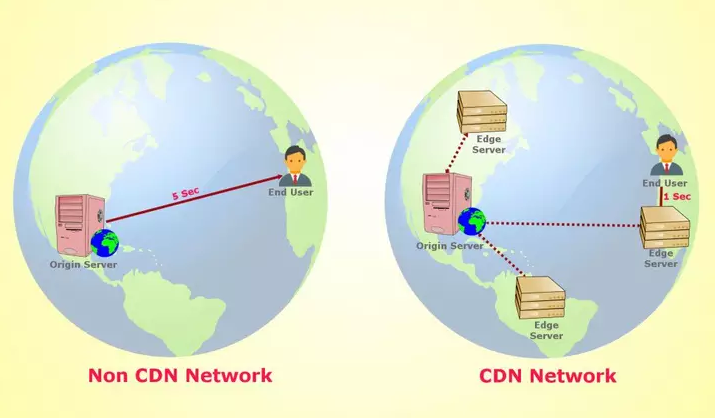
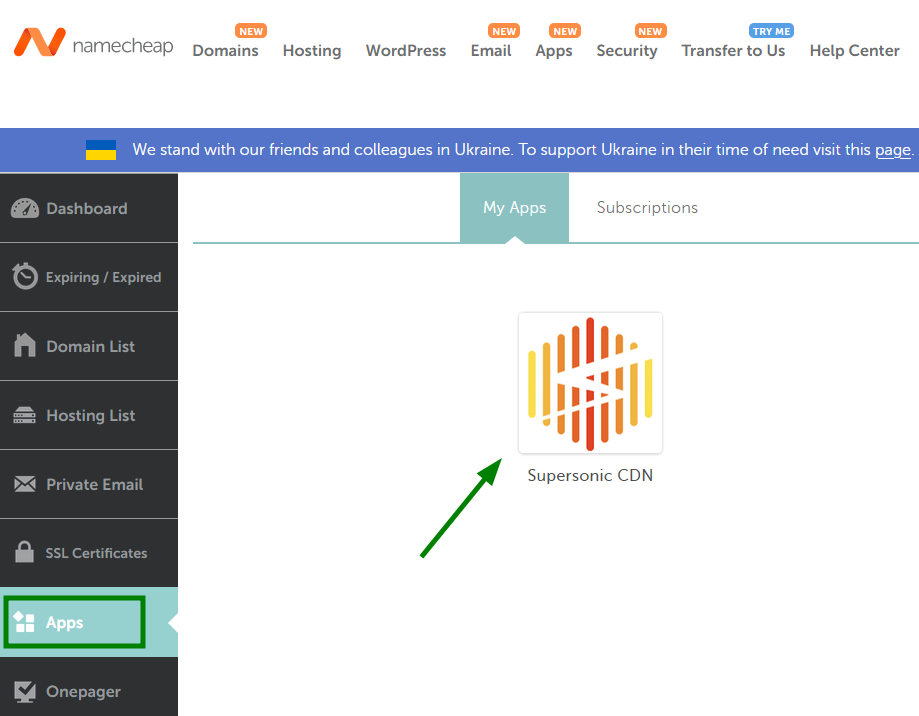
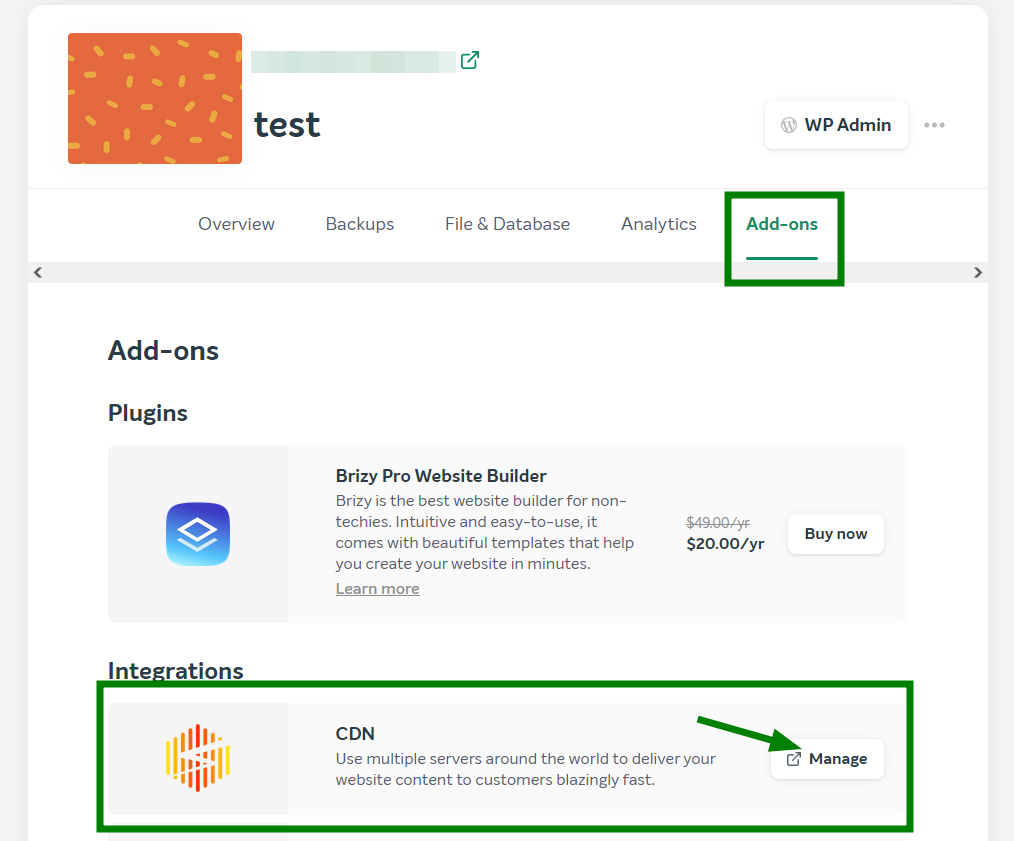
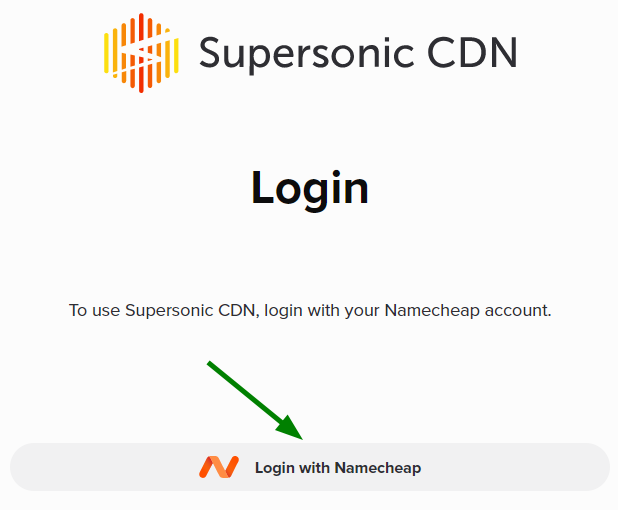
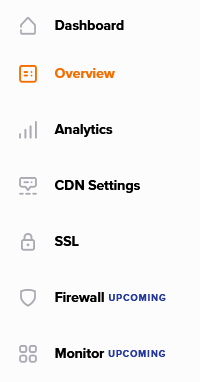

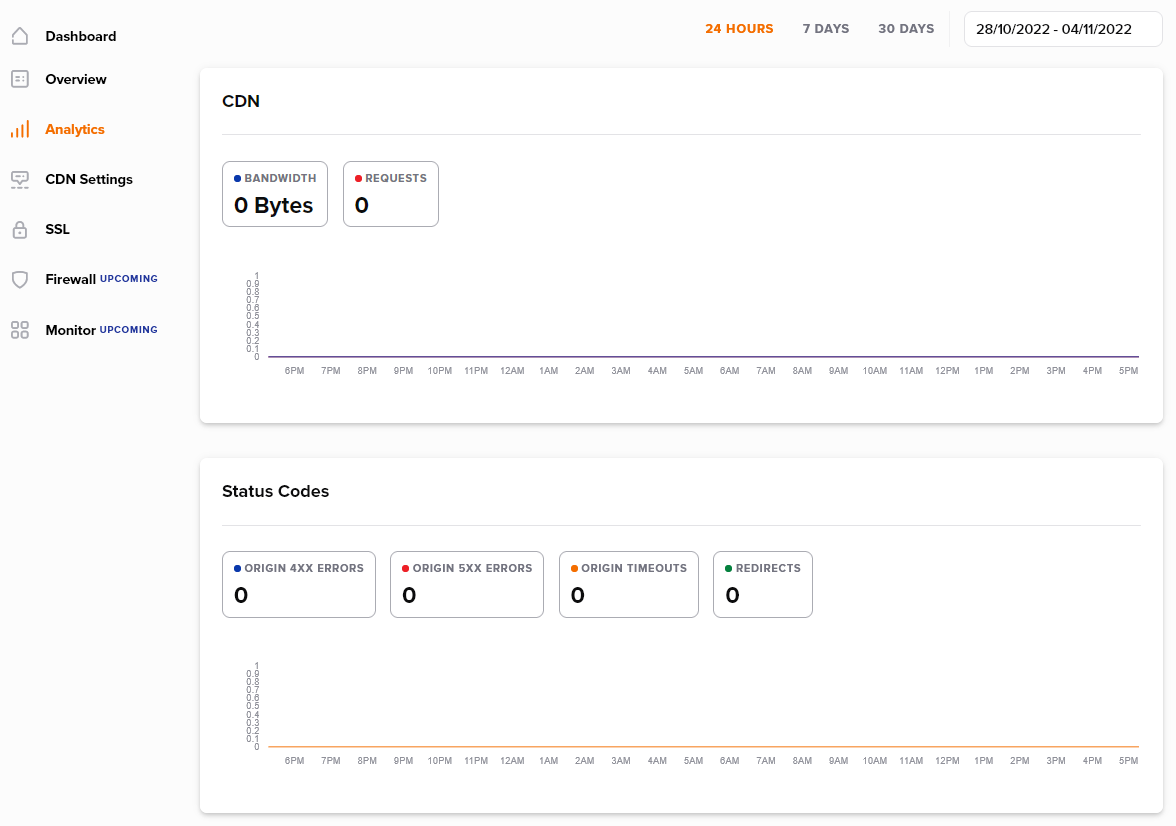


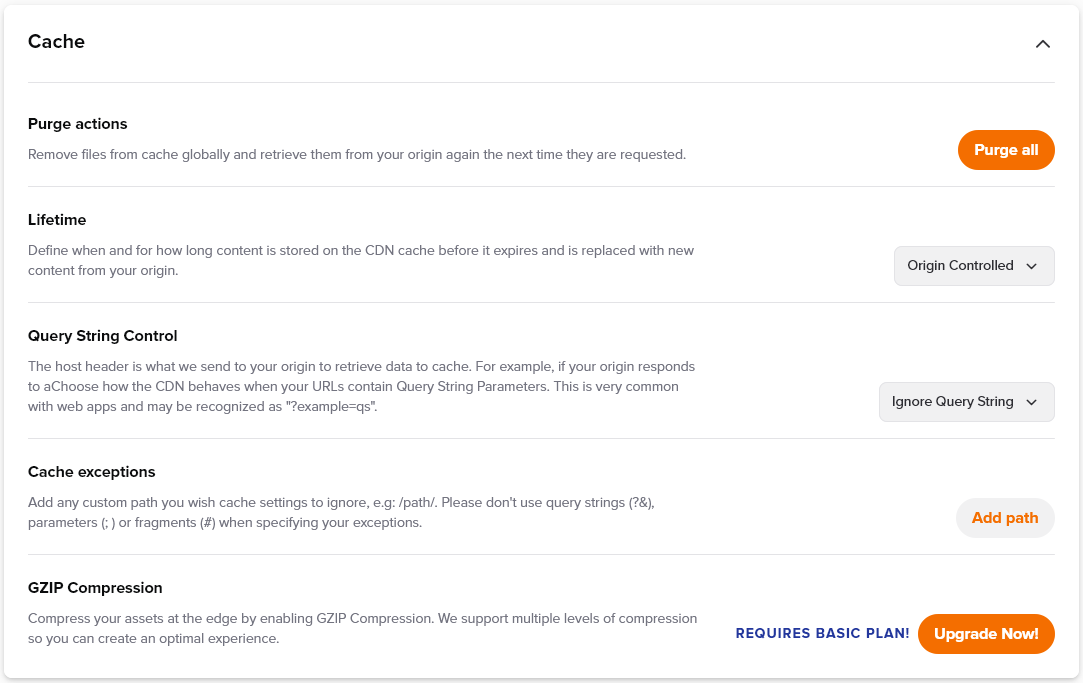
This is useful if you have URLs in your site with query strings - that is, if you have several versions of the same file.
URLs that contain string parameters will be controlled from your origin server.
With the help of the Cache exception option, you can choose a URL that won’t be cached — for example, if you want to cache only static content.

{}Need help? We're always here for you.
{}